Although the previous night I went to bed around midnight, I didn’t find it difficult at all when I woke up right after the sunrise and that was around 6 am. The light was slowly penetrating through the walls of my cabin-room and I also heard the sound of waves, which all together formed a very appealing invitation. Since my cabin was in the second or the third row, merely a dozen metres separated me from the beach, so I got up and went for a very short walk.
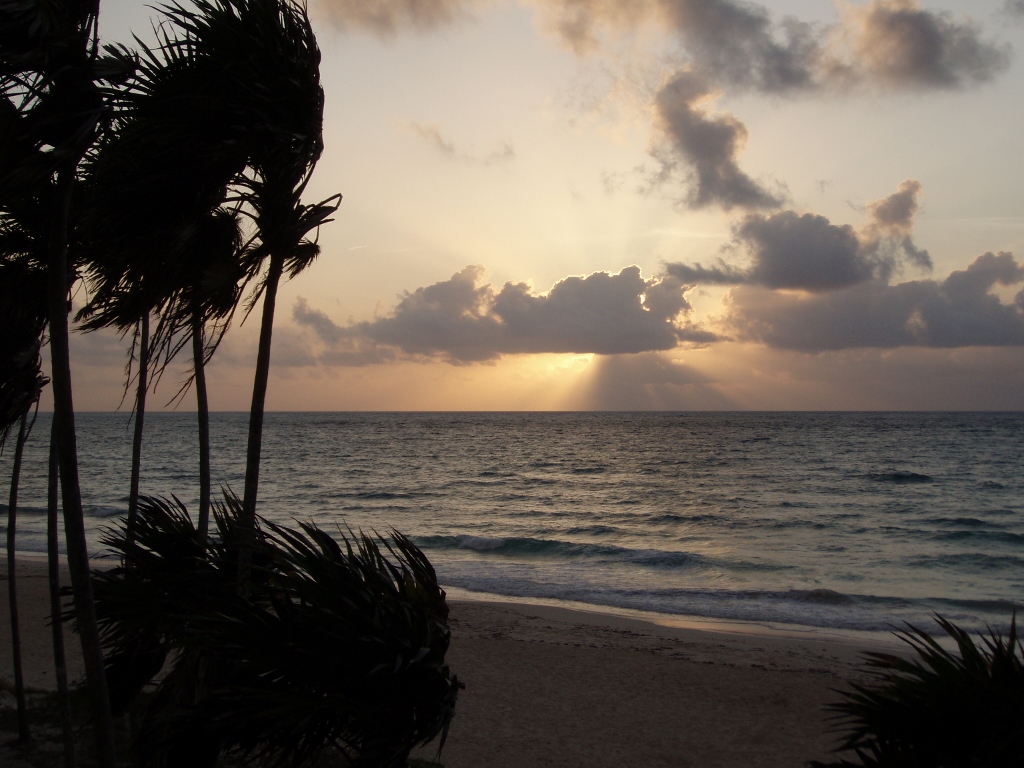 Early morning in Tulum
Early morning in Tulum
I did not stay on the beach for long, since I planned to go for another walk. I took everything I needed from the room and then I got out of the hotel and into the street which was in fact more of a road that follows the shoreline and numerous hotels dotted along that coast. After a couple of hundred metres I came across a fork in the road and the road going to the left actually led directly into town, but I was not interested in that and just continued straight. The place I was heading for this early was an archaeological site that was some 4 km north of my hotel which meant that this was a walk of less than one hour. This early in the morning there were not many cars, but it was already starting to be hot, that is, the air humidity was high, so I was all covered in sweat by the time I got to the site which was around 7.15 am. Needless to say, it was still not open, so I just peered through the gate that is used as the exit after the visit to the site.
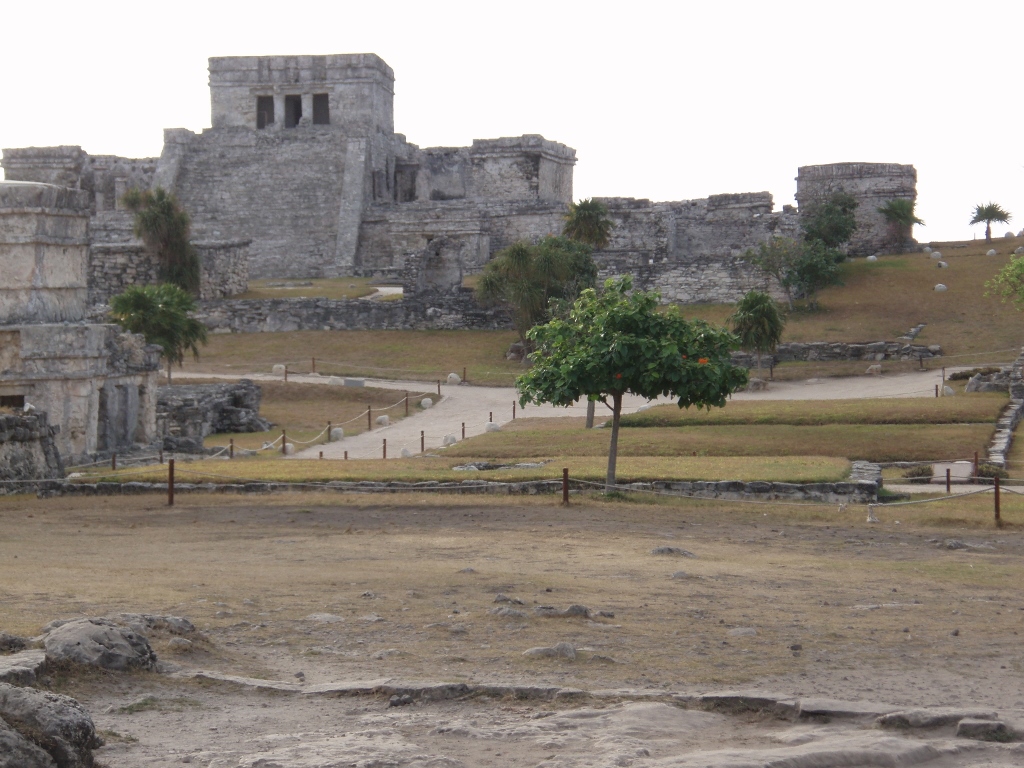 Archaeological site in Tulum before the opening; the highest structure is El Castillo
Archaeological site in Tulum before the opening; the highest structure is El Castillo
The site was one of the last cities built and inhabited by the ancient Mayas and it reached its peak between the 13th and the 15th century. It seems that the demise of Tulum was facilitated by the diseases brought here by the Spanish, so after the overall decline the settlement was completely abandoned by the end of the 16th century.
There are some indicators that the city was originally called Zama, meaning “dawn,” which makes sense since it was built on a 12-m high cliff that is a part of the east coast of Yucatan. Even the present-day name Tulum has its meaning in the local Mayan language and it is “fence” or “wall,” which again makes sense since it was surrounded by stone walls that protected it from invaders.
Having arrived here earlier, I killed the time sitting on a low wall and then at 8 am the gates to the site were opened.
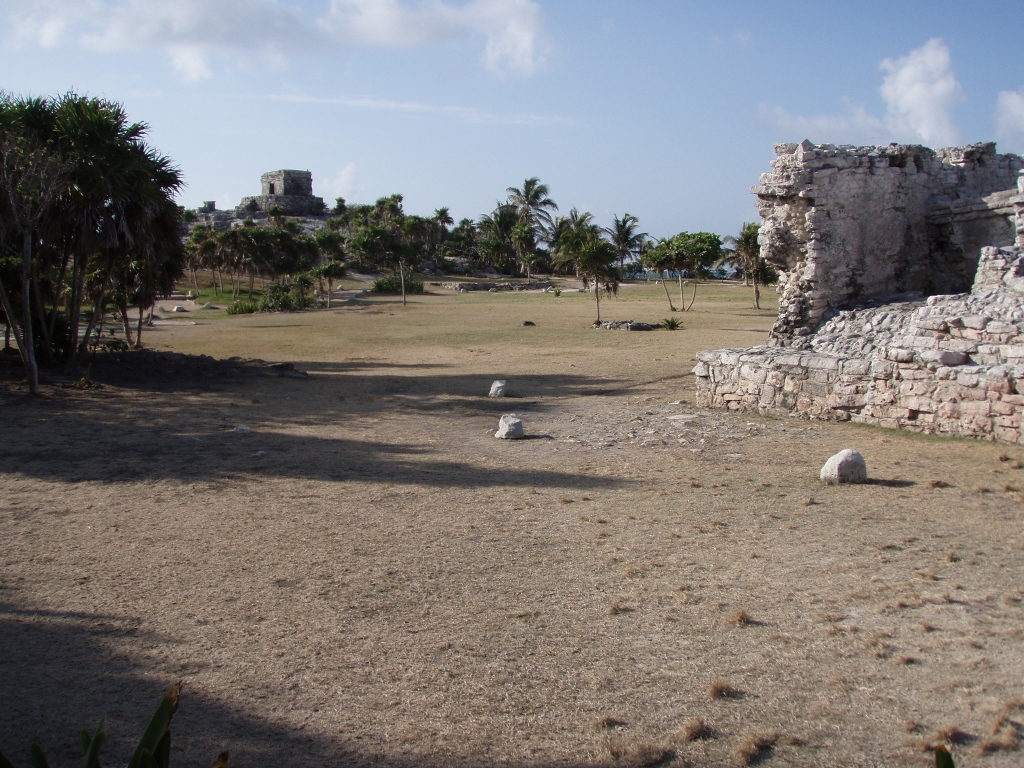 Entering the archaeological site in Tulum
Entering the archaeological site in Tulum
One of the first structures one comes across is the Cenote House (Casa Cenote). The reason why the structure got this name is that underneath it there is an underground well of freshwater. While I was standing in front of the Cenote House, its first room with pillars reminded me of antique atriums, while in the middle of the next room it is possible to see an opening in the floor that could probably be the top of that cenote. I could not corroborate personally, however, since it was not permitted to enter the realm of the house.
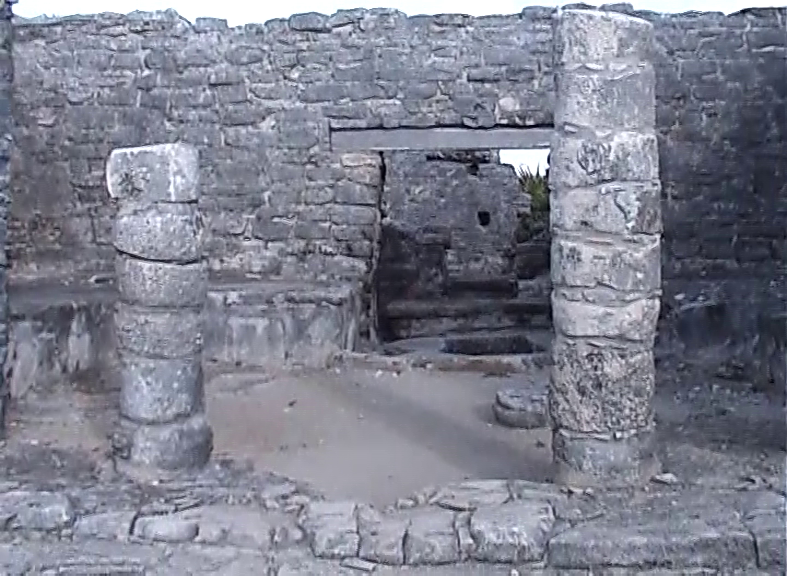 Cenote House
Cenote House
From the path that leads in front of the Cenote House there is a fine view at a couple of other structures within the site.
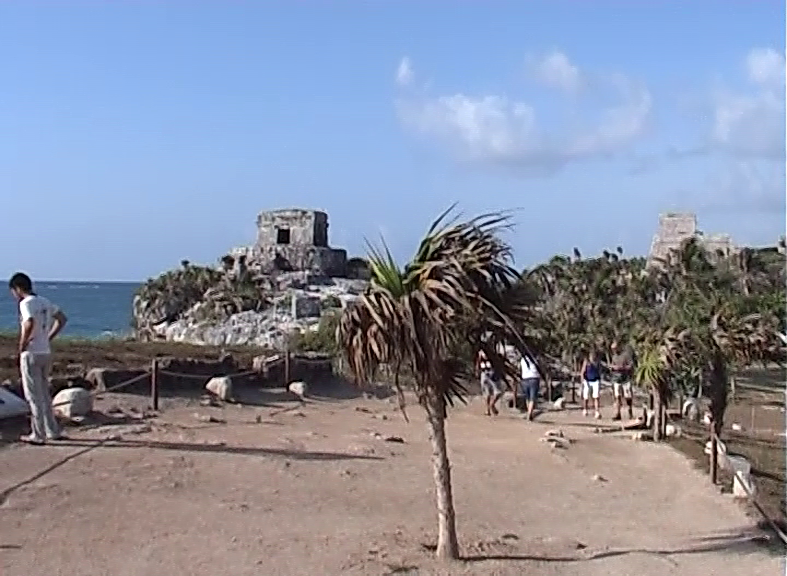 Temple of the Wind God (left) and El Castillo (right, farther away)
Temple of the Wind God (left) and El Castillo (right, farther away)
Then I got to a place from which I could see better the Temple of the Wind God (Templo del Dios del Viento), as well as parts of the magically beautiful Caribbean Sea near Tulum.
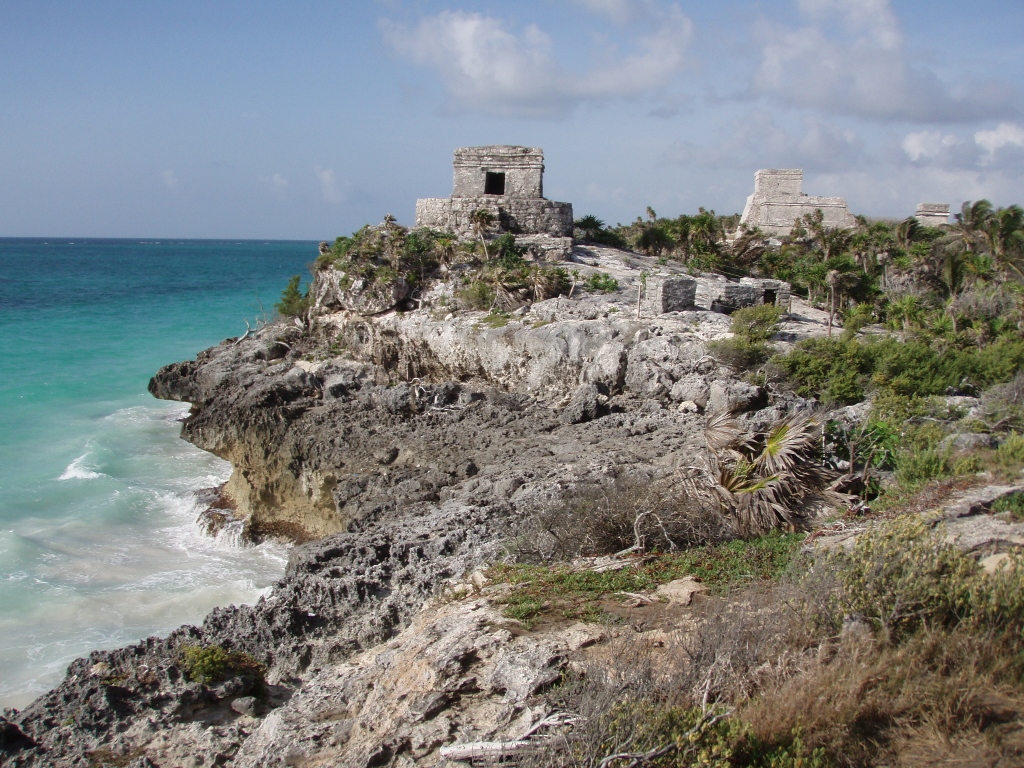 Temple of the Wind God
Temple of the Wind God
It is presumed that this structure, often marked by number 45, was dedicated to the wind god since it is placed on a circular base that is traditionally linked precisely to the wind god, since wind blows from all sides and the absence of angles should allow for unhindered blowing. It is also considered unusual that the entrance into the temple faces north and this is seen in the photo above.
The visitors’ path further leads around the Temple of the Wind God and then it descends to the level of the coast, i.e., a gorgeous sandy beach.
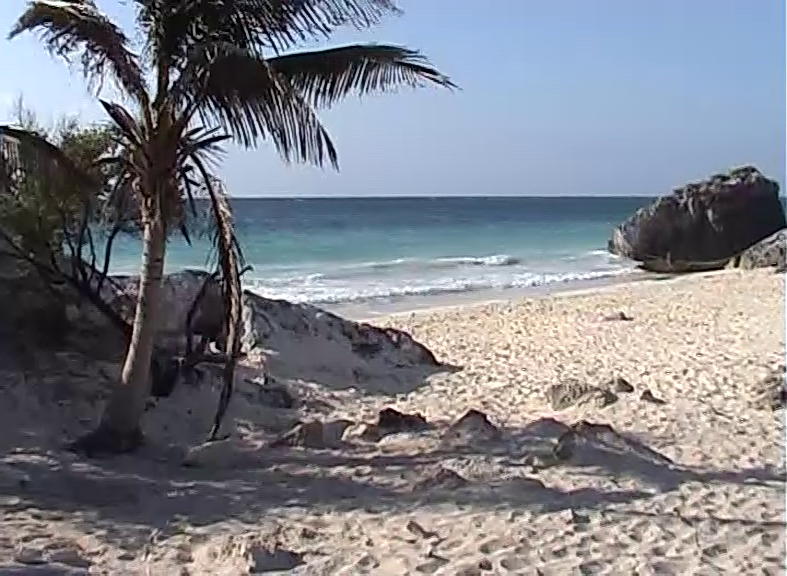 Tropical sandy beach in the middle of an archaeological site
Tropical sandy beach in the middle of an archaeological site
Still, no matter how attractive, this beach is not earmarked for the swimming of visitors and in this regard it is quite clearly and visibly fenced off. The beach is in fact situated between two small elevations. On one of them is the Temple of the Wind God, while on the other is El Castillo, the most imposing structure at the site.
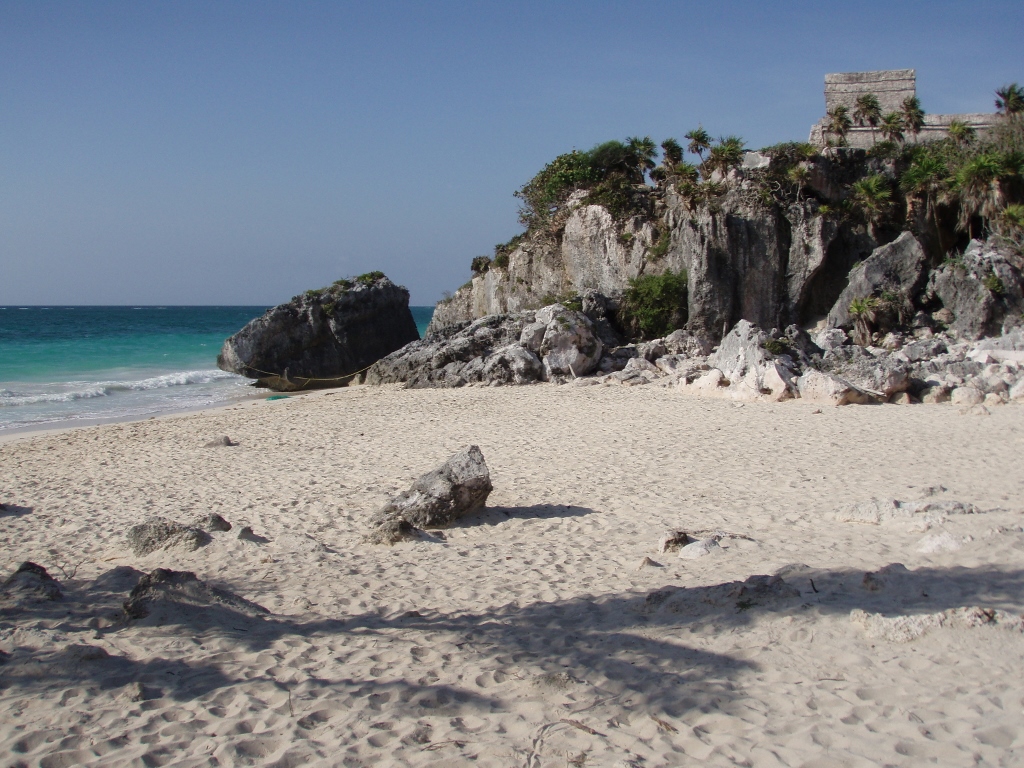 Beach and on the top of the elevation you can see the north side of El Castillo
Beach and on the top of the elevation you can see the north side of El Castillo
Following the path I ascended again onto the elevation and there I first came across the House of the Halach Uinic (Casa del Halach Uinic) or the Overlord, which is in some places marked as the Palace.
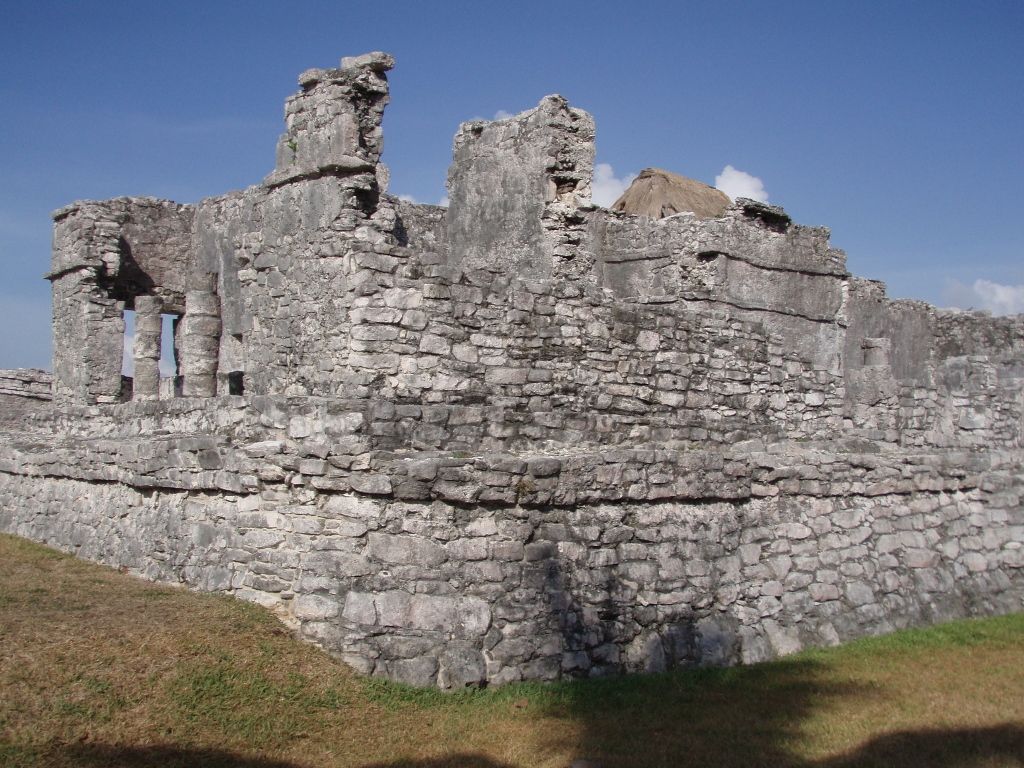 House of the Halach Uinic
House of the Halach Uinic
A little farther down the path there is also the House of Columns.
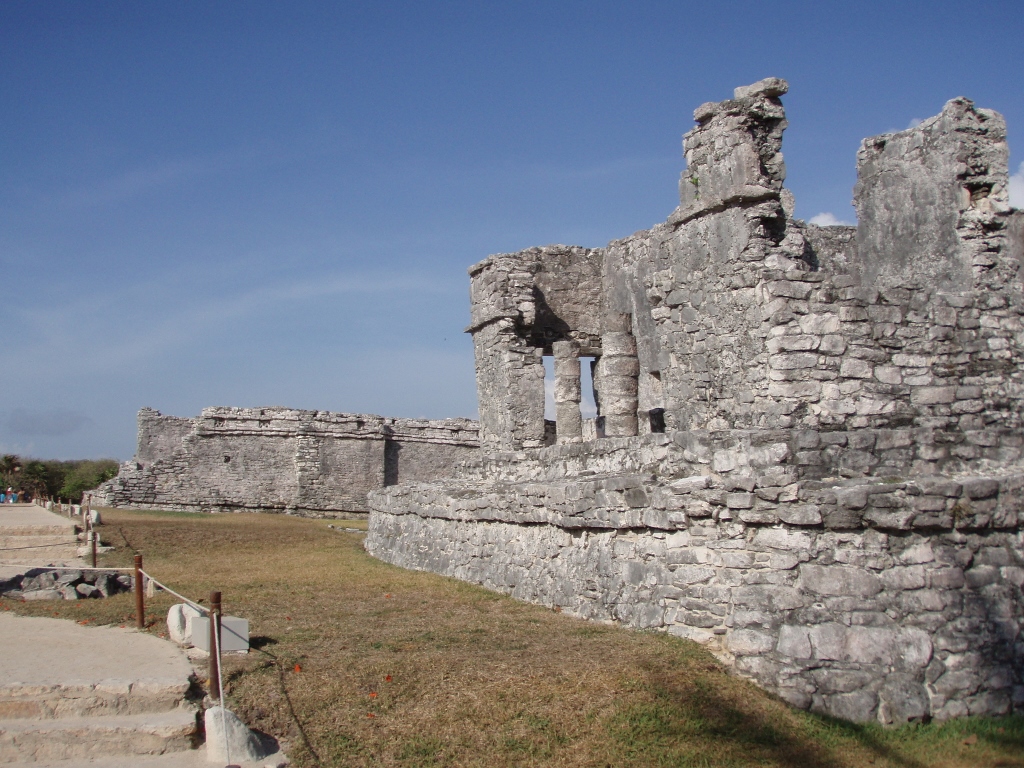 Archaeological site in Tulum
Archaeological site in Tulum
However, before going there, I turned to the other side and there was the Temple of the Descending God (Templo del Dios Descendente).
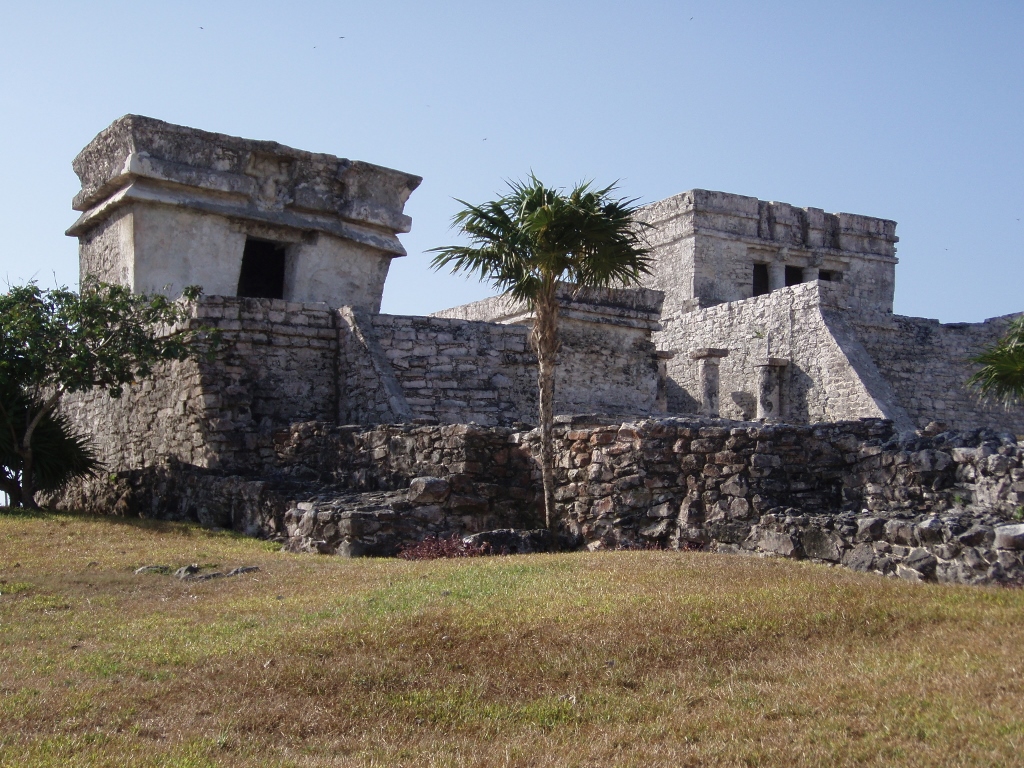 Temple of the Descending God (left) and El Castillo (right)
Temple of the Descending God (left) and El Castillo (right)
Right above the doorway one can see the depiction of this god – his legs are up, while his head and the arms are down, as if it is falling, i.e., descending from the sky. It is presumed that this is the symbolised setting Sun.
Although the photo above also shows El Castillo, I focused first on the other structures standing on the other side in relation to the visitors’ path.
Thus I got closer to the already mentioned House of Columns (Casa de las Columnas) which is often marked as the Great Palace (El Gran Palacio). This is one of the biggest structures at the site and it is characterised by columns, which can easily be deducted from the name. There are four columns at the entrance, while six columns carry the ceiling in the main room.
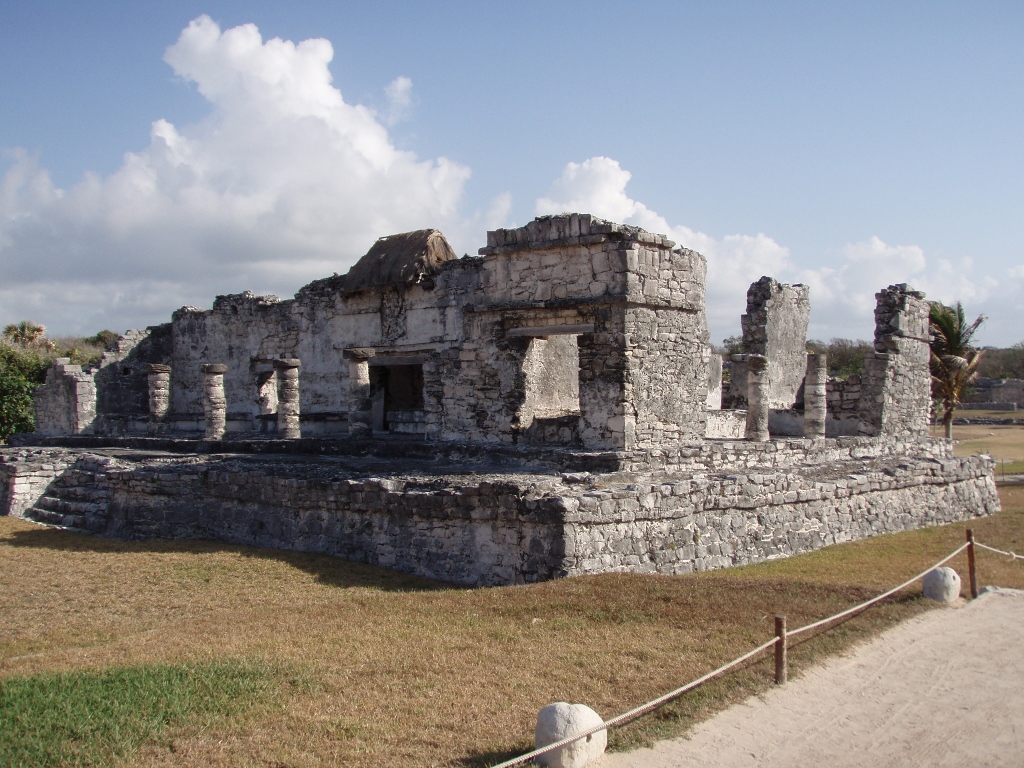 House of Columns
House of Columns
The next structure was the Temple of the Frescoes (Templo de los Frescos) that I first approached from its back side.
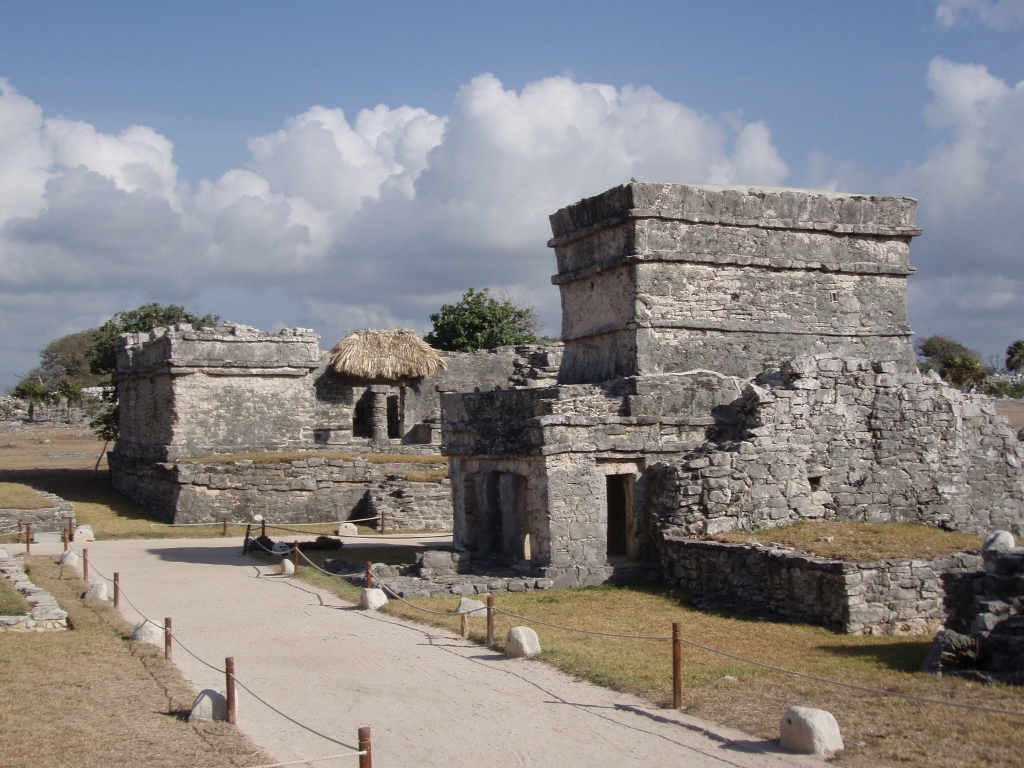 Temple of the Frescoes is on the right-hand side of the photo, while a little farther away is the Chultún House (Casa del Chultún)
Temple of the Frescoes is on the right-hand side of the photo, while a little farther away is the Chultún House (Casa del Chultún)
As can be seen in the photo above, around all of these structures there are small poles and a rope, which more than clearly means that entering the structures is off limits. This, however, meant nothing to some of the visitors, until the guards came who chased them away. In fact, there is not much need to enter the temples, since their most important features can be seen from the path as well.
To start with I made a circle around the Temple of the Frescoes and so I could see El Castillo in its background.
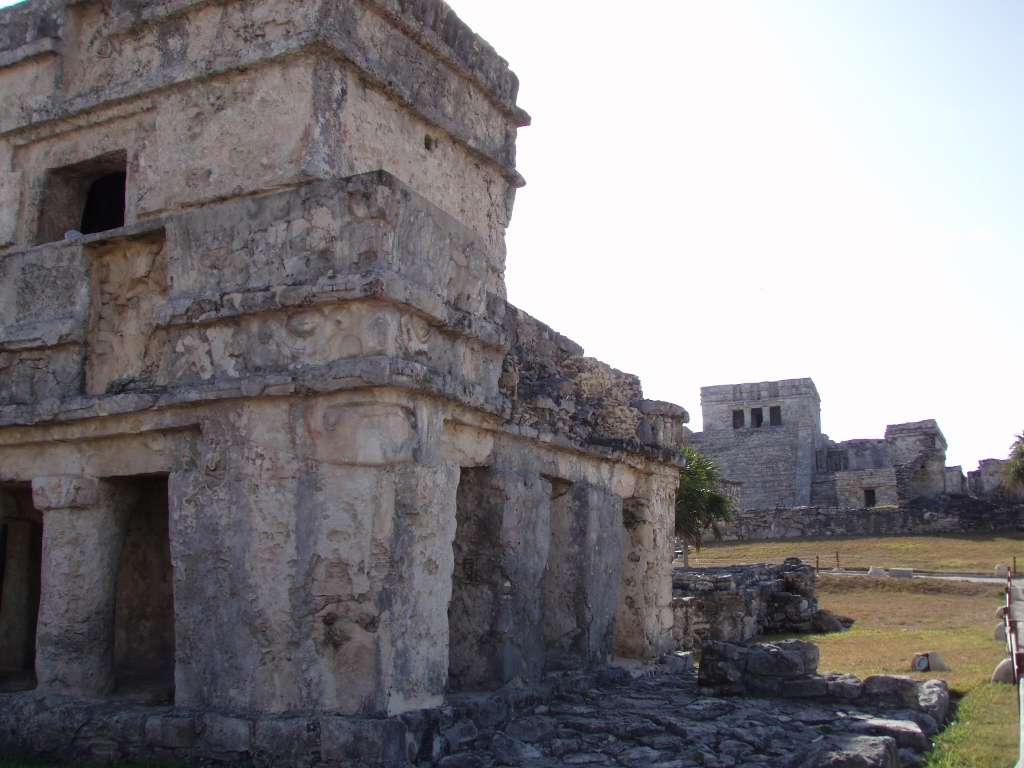 Temple of the Frescoes and El Castillo
Temple of the Frescoes and El Castillo
When you approach the Temple of the Frescos from the front side you can see different interesting elements already on the facade itself. For instance, to the left from the window opening on the upper floor you can see red hand prints, while on the frieze between the floors there is again the descending god, that is, as I’ve said, it is presumed that this was the symbolic depiction of the setting Sun. After all, the front side of the temple faces west.
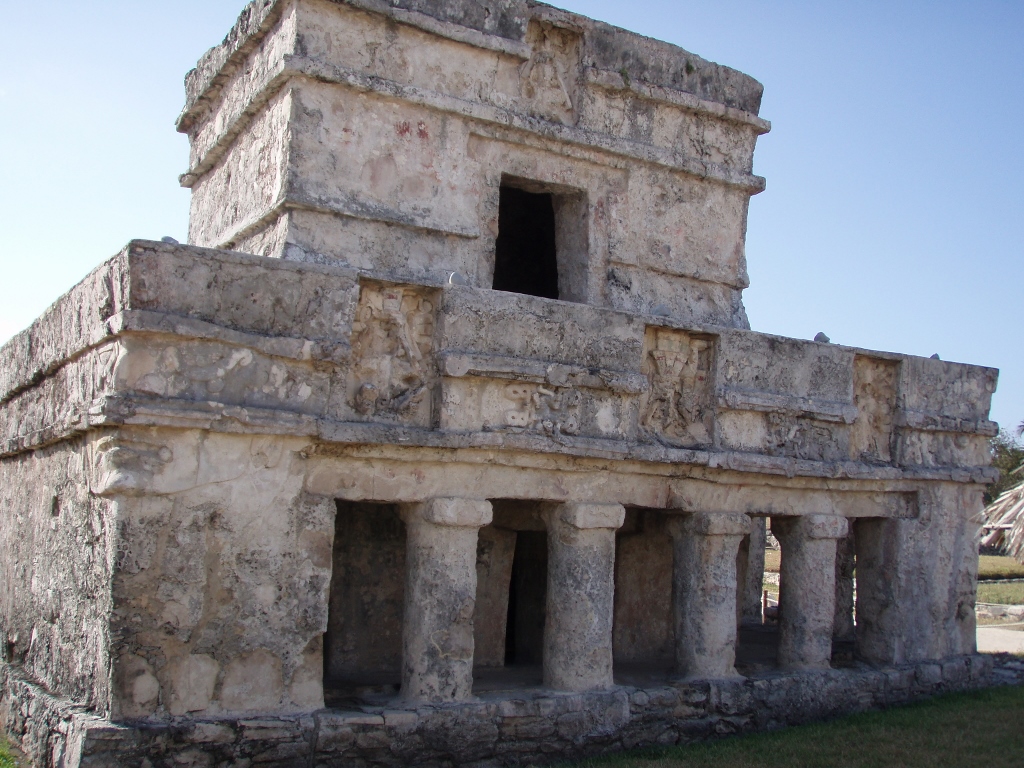 Temple of the Frescoes
Temple of the Frescoes
And when you look more closely, on the back wall of the porch (the area behind the columns) you can see very well preserved wall paintings.
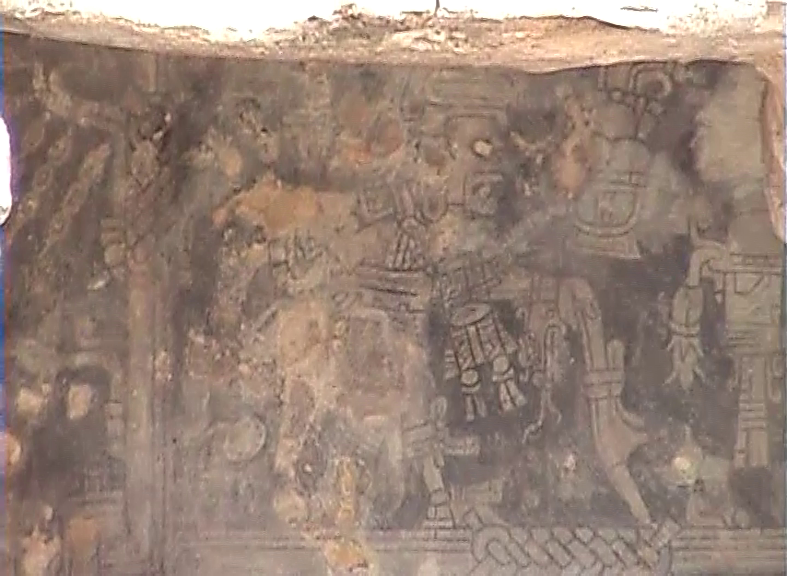 Wall paintings at the Temple of the Frescoes
Wall paintings at the Temple of the Frescoes
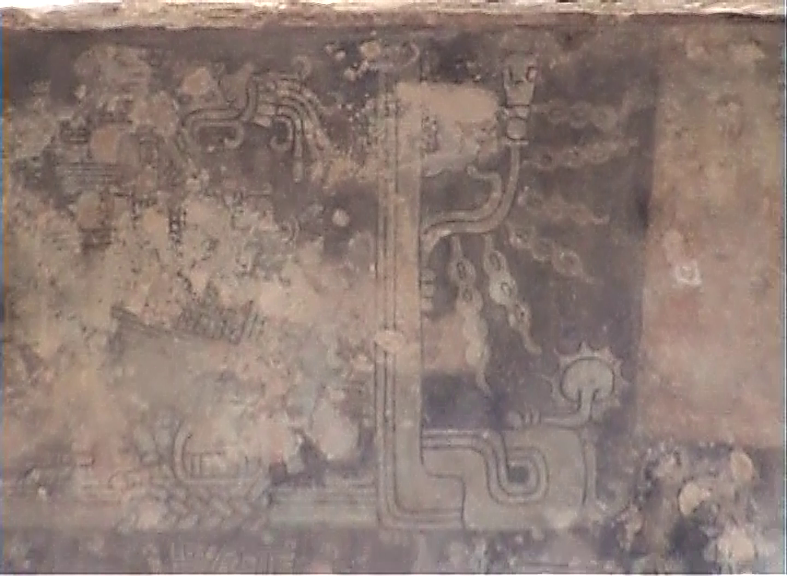 Wall paintings at the Temple of the Frescoes
Wall paintings at the Temple of the Frescoes
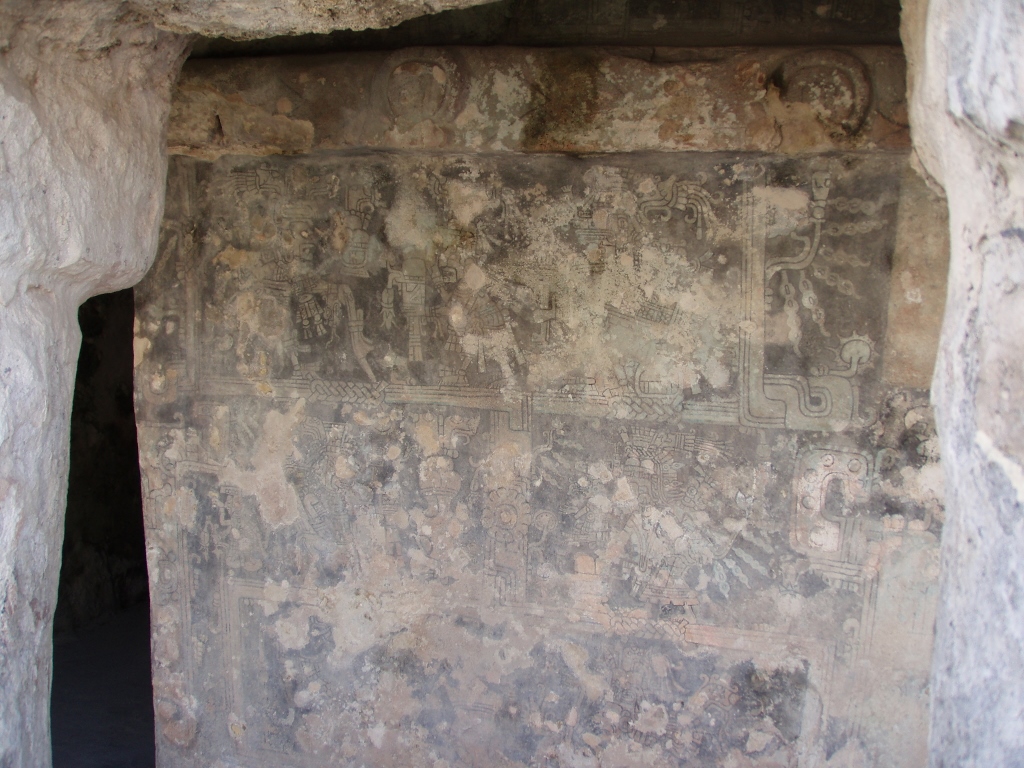 Wall paintings at the Temple of the Frescoes
Wall paintings at the Temple of the Frescoes
After the Temple of the Frescoes I finally paid some more attention to El Castillo.
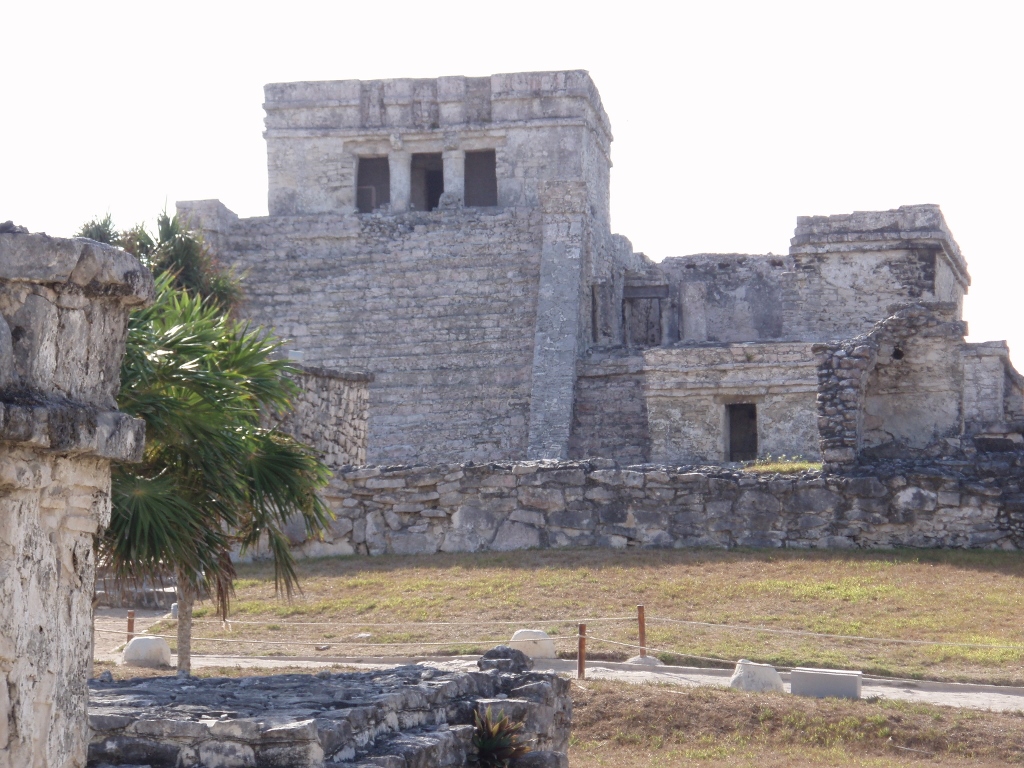 El Castillo
El Castillo
It was not permitted to get closer to this structure or to climb on it, so looking at it from different distances was all that could be done, but this was more than fine, since its beauty came from the outside and because of the interesting aspects linked to its presumed purpose. El Castillo means “castle,” but it all suggests that this structure did not play any role of a castle, rather it served as a beacon.
Namely, Tulum was one of the very important trading centres at the time of the ancient Maya people, both for the land and for the maritime trades. Since there is a massive coral reef extending along the east coast of Yucatan and consequently also along Tulum (by the way, one of the biggest in the world), this constituted a big problem and a natural obstacle for different vessels that were supposed to approach the shore. This structure was built precisely in the spot that marks a short interruption in the coral reef that exists opposite El Castillo. When the vessels passed through the coral reef thanks to this guiding, then it would be easy for them to approach the cove and the landing beach that I had previously walked by.
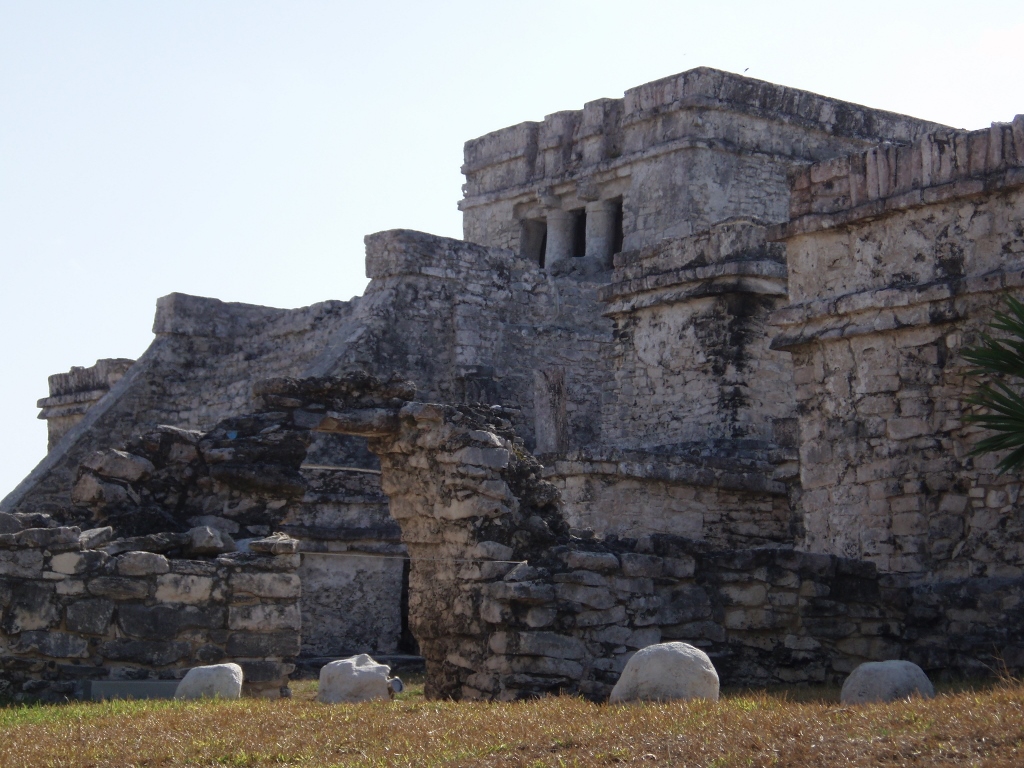 El Castillo
El Castillo
Now I first returned in front of El Castillo and then I walked to the Temple of the Descending God, only to follow the path that went behind their back sides.
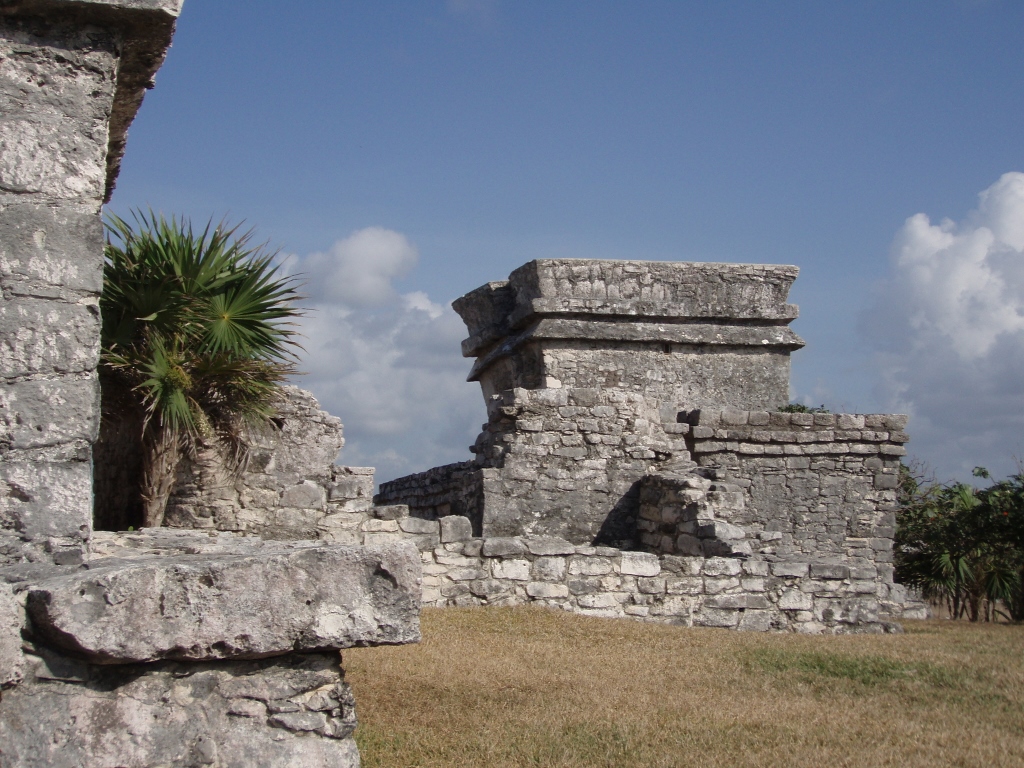 Temple of the Descending God as seen from the back
Temple of the Descending God as seen from the back
However, no matter how interesting these buildings were, there was something here that I found much more impressive than the stone walls.
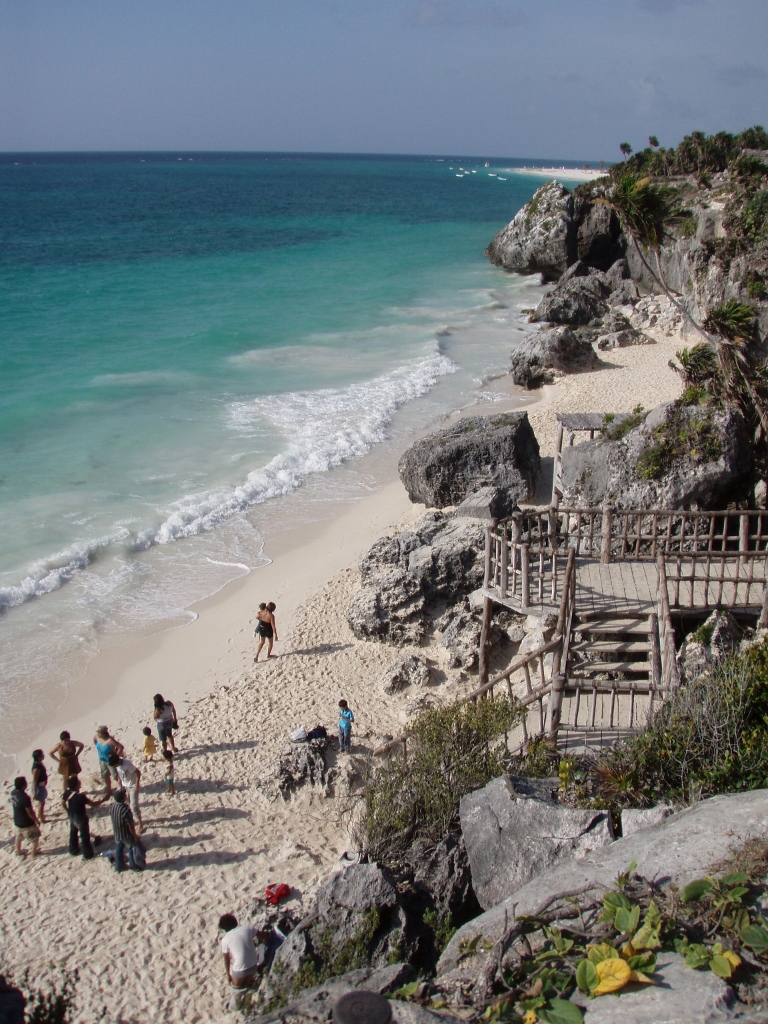 Beach below the cliff on which El Castillo was built
Beach below the cliff on which El Castillo was built
As it may be noticed in the photo above, it was possible to swim on this beach and this was further facilitated by the fact that the access to the beach was provided by the way of a large wooden staircase. Also, a little farther away I could see a bright white sand beach of an expensive hotel. How do I know that this beach belonged to an expensive hotel? Very simply – such an impressive place cannot be taken by a hostel with 0.5 stars.
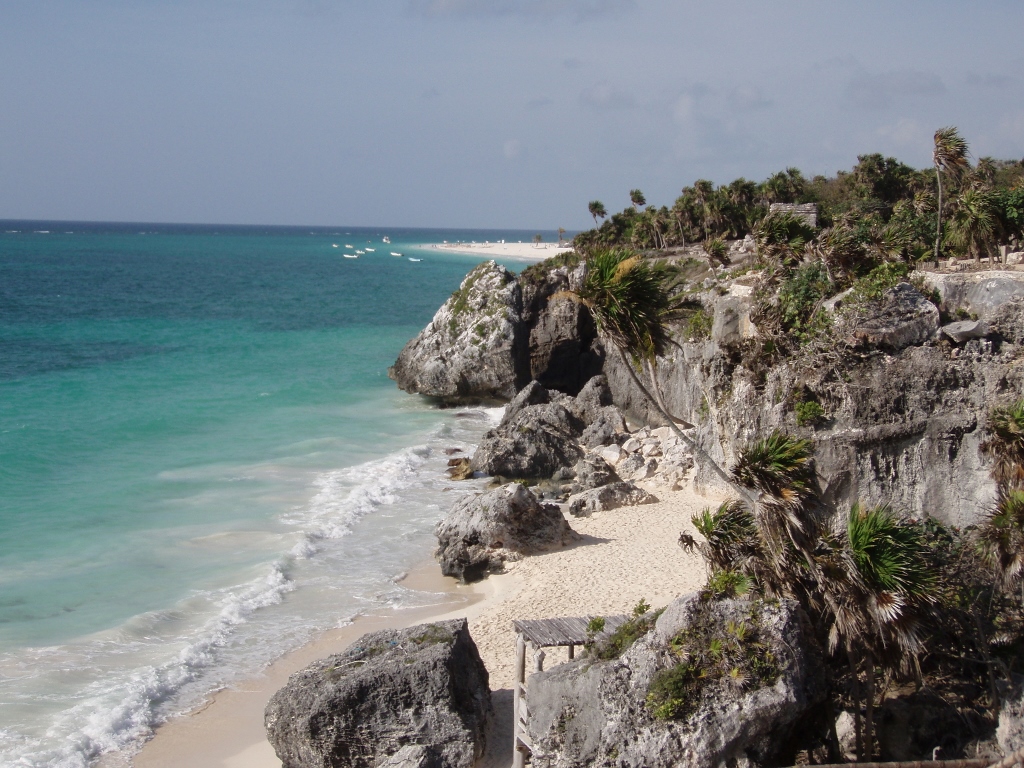 Beach by the archaeological site and a little farther away the beach of an expensive hotel
Beach by the archaeological site and a little farther away the beach of an expensive hotel
Then I faced north and there I could see very nicely the cove and the beach on which the swimming was not allowed, as well as the Temple of the Wind God.
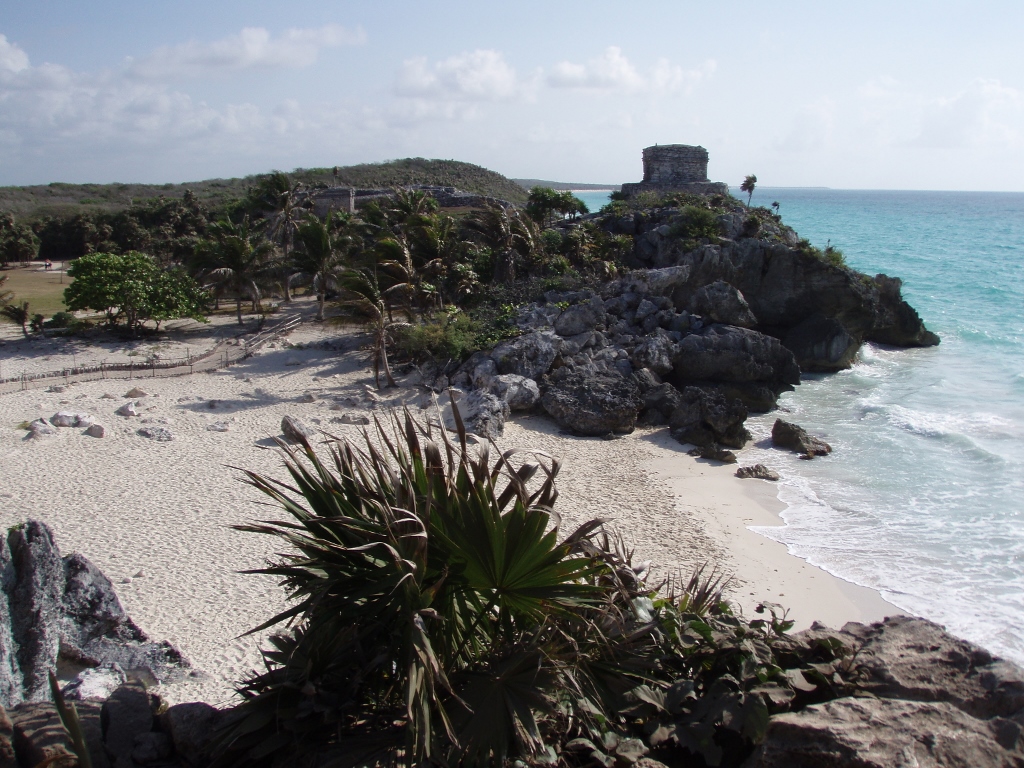 The beach only to be looked at and admired
The beach only to be looked at and admired
I continued with my walking along a wide path that follows the edge of the cliff and a little farther away I had an excellent view at the back of El Castillo, as well as the staircase that leads down to the beach for swimming.
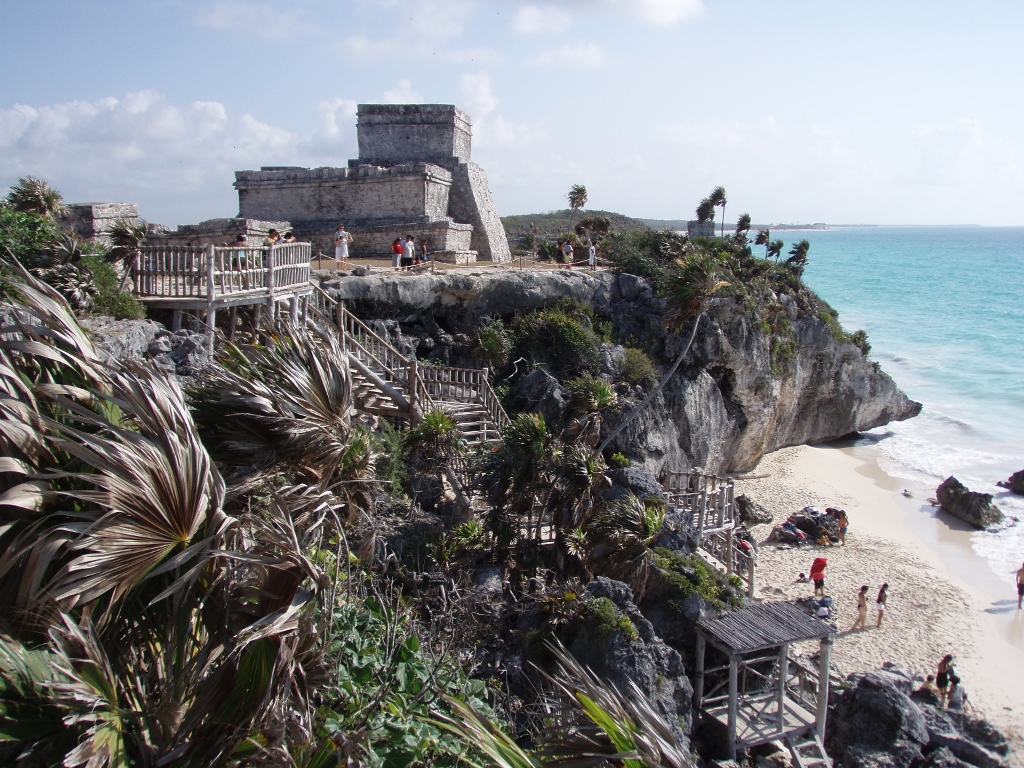 El Castillo and the swimming beach
El Castillo and the swimming beach
The sights and the colours were wonderful, so I felt the need to make a self-portrait.
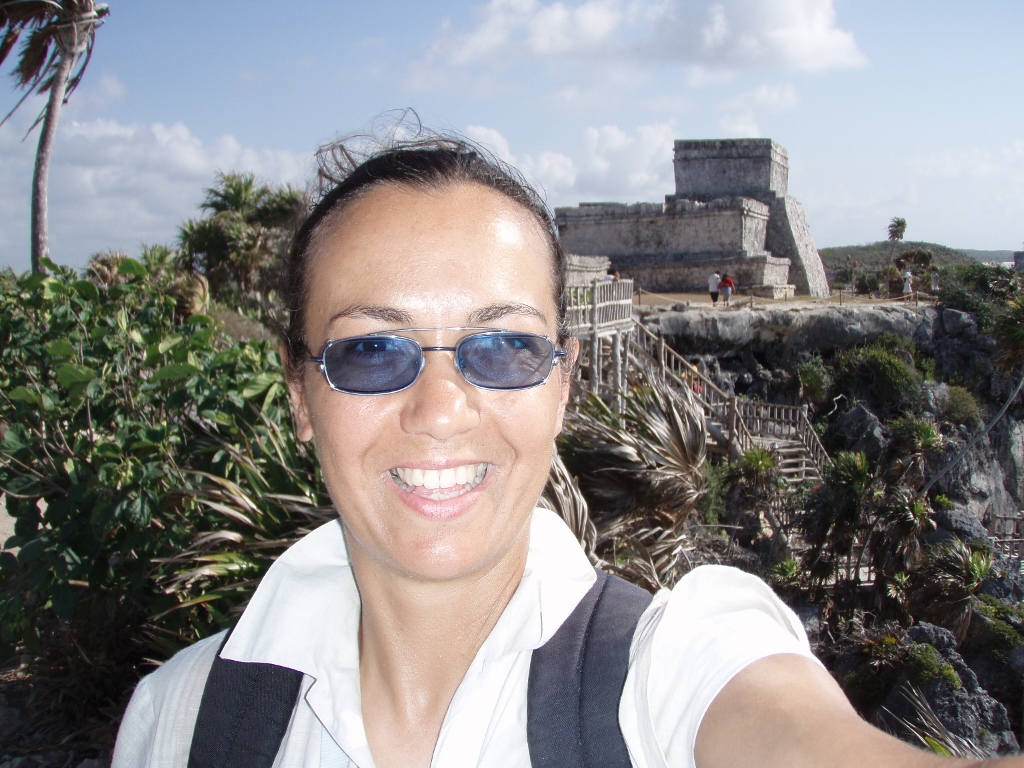 Self-portrait with El Castillo
Self-portrait with El Castillo
By the time I walked some 50 m more and looked back, there were already people swimming in the sea, for this is a public beach called the Ruins Beach (Playa Ruinas).
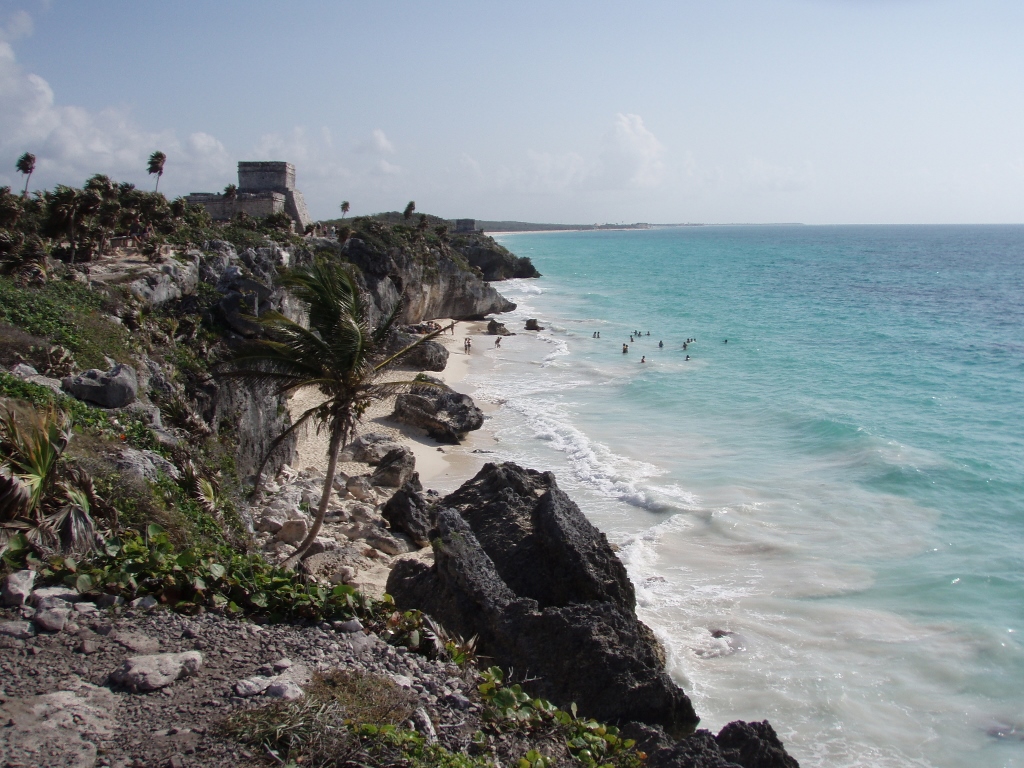 Swimming on the Ruins Beach
Swimming on the Ruins Beach
The beach or, better said, the beaches in Tulum are among the most beautiful in Mexico. This is always, of course, the question of personal preference, but here is a short video that may illustrate this better than a static photograph.
When I got to a structure at the end of the site I saw an iguana sunbathing there. I think that something was wrong with its tail, but then again this did not seem to bother it.
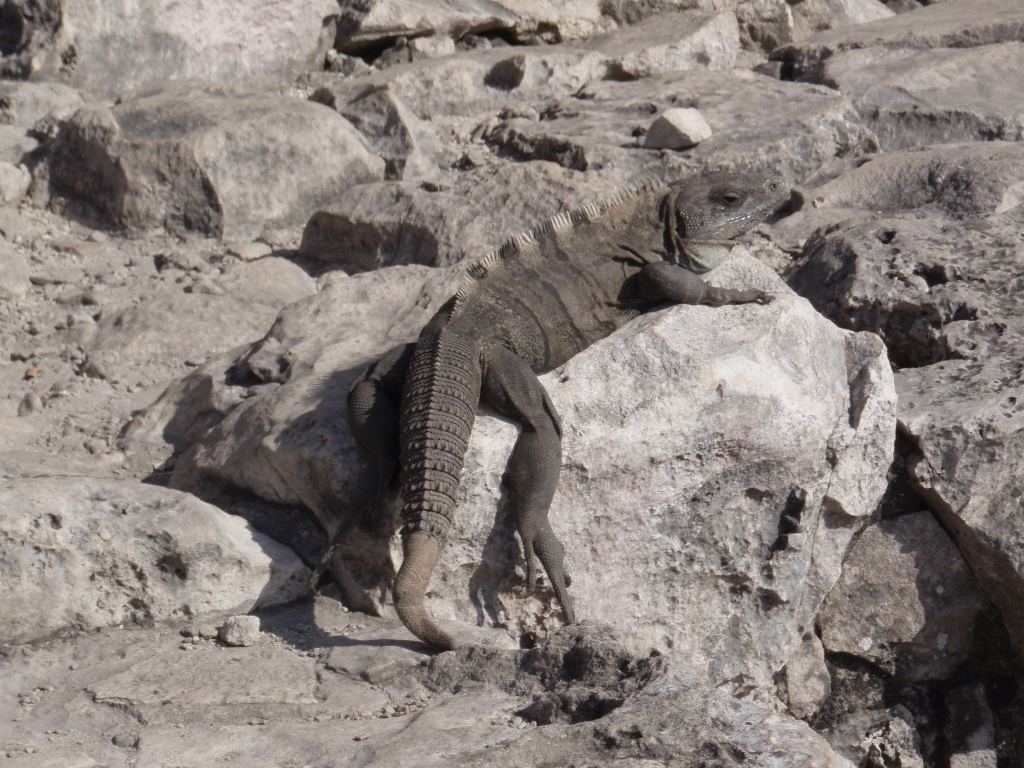 Sunbathing iguana
Sunbathing iguana
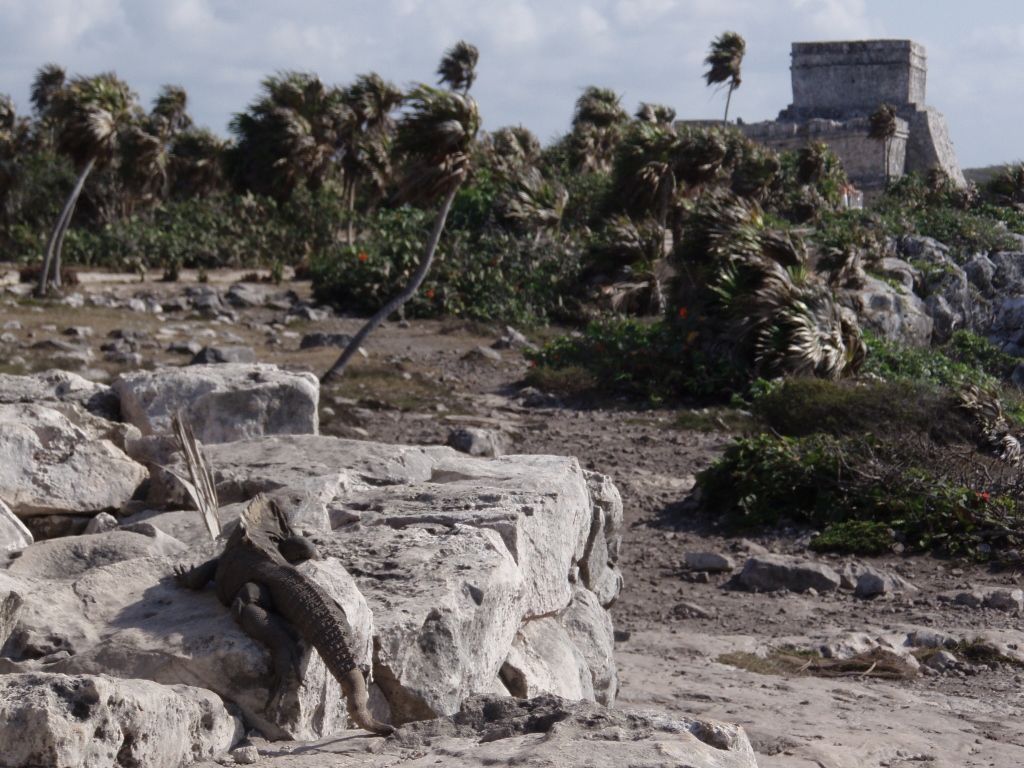 Iguana in the foreground and El Castillo in the background
Iguana in the foreground and El Castillo in the background
From here, I started slowly to go towards the exit. Along the way I kept taking photos of different parts of the archaeological site Tulum. The following photo shows a passage in a wall made as a corbel arch leading into the yard in front of El Castillo, but as it can be discerned in the photo, there was a rope that clearly marked the prohibition of passage.
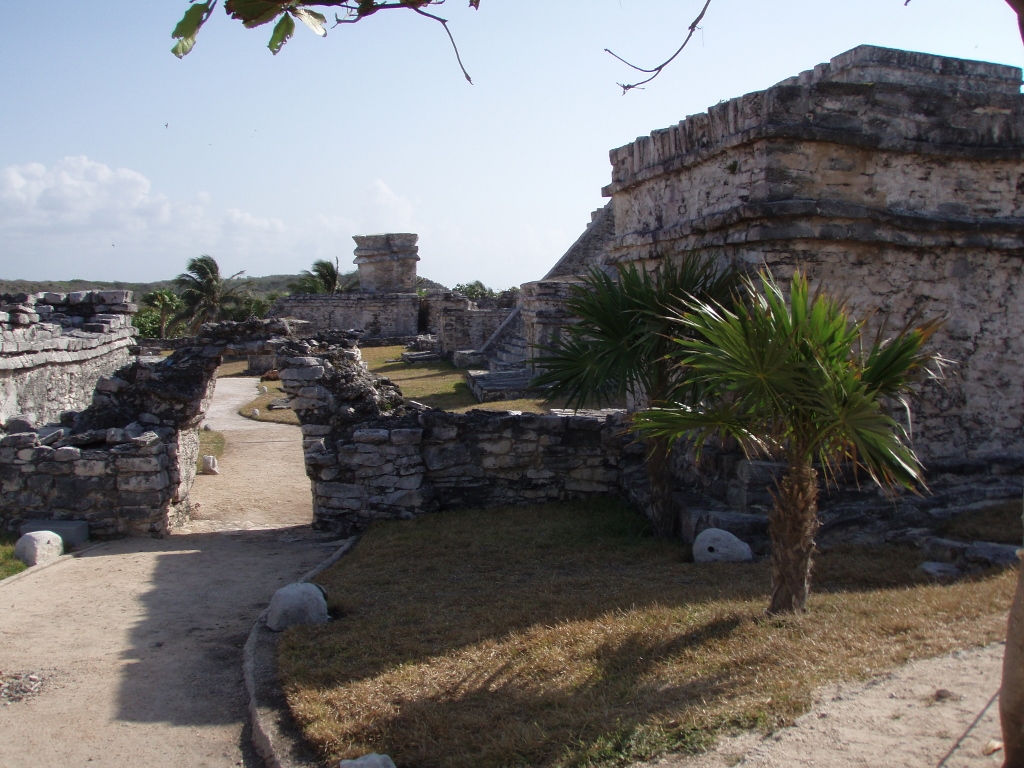 Details from the site of Tulum
Details from the site of Tulum
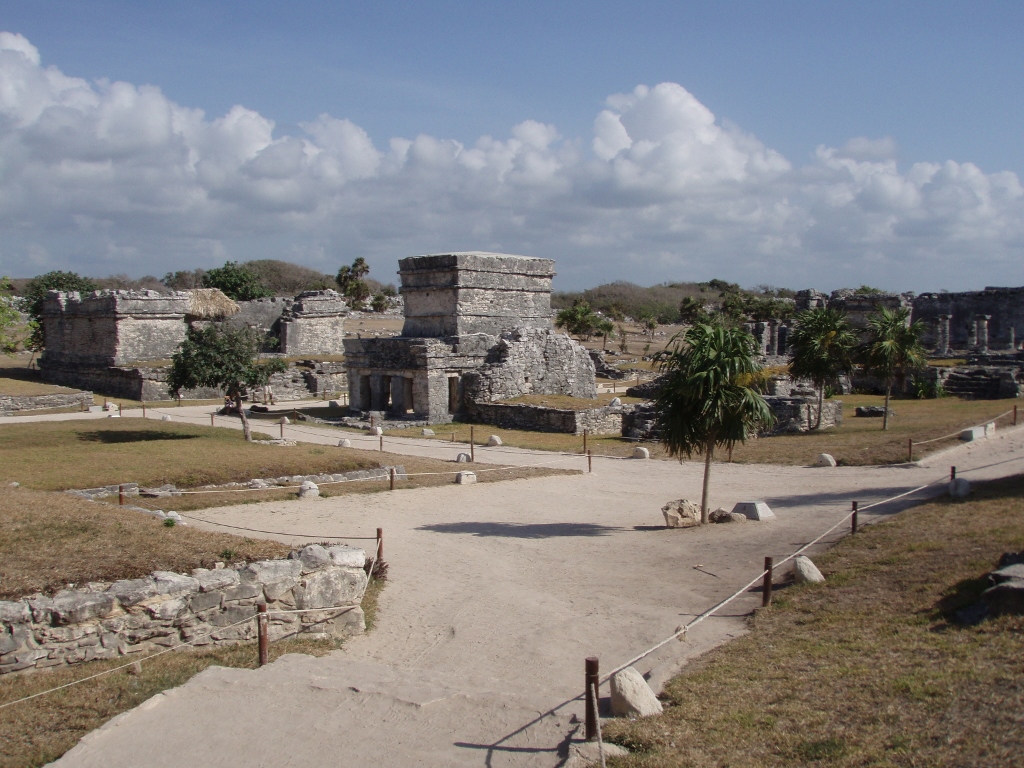 Archaeological site Tulum: the Temple of the Frescoes is in the middle
Archaeological site Tulum: the Temple of the Frescoes is in the middle
When I exited the site, my intention was to go to the centre of Tulum town that was only some 3 km away, so I planned to cover the distance on foot.
Just as I left the area of the site, I got to a crossroad and there I saw a man sorting things out about his motorcycle. I asked him which way it would be best for me to go to get to the centre and then he asked me where exactly I was going, offering to take me there. He had just brought his wife who worked at the site, so he was going home. Since I agreed, he first gave me a helmet and then we started. I was truly quite jovial and even managed to get my video-camera out and briefly record the experience.
So, I transferred in this way to the coach terminal, but they said again I could not buy the ticket that day and to come again the day after. What a bunch of wallies!!! They had said the same thing the previous day as well. Still, I took advantage of being downtown, so I went to a nearby internet-café. While I was there, Lydia and Paul came and this was one very joyful reunion.
Then I went for a light lunch to one very simple restaurant – this day it was going to be tacos with chicken. Irrespective of the modesty of the restaurant and the simplicity of the dish, the lunch was excellent!
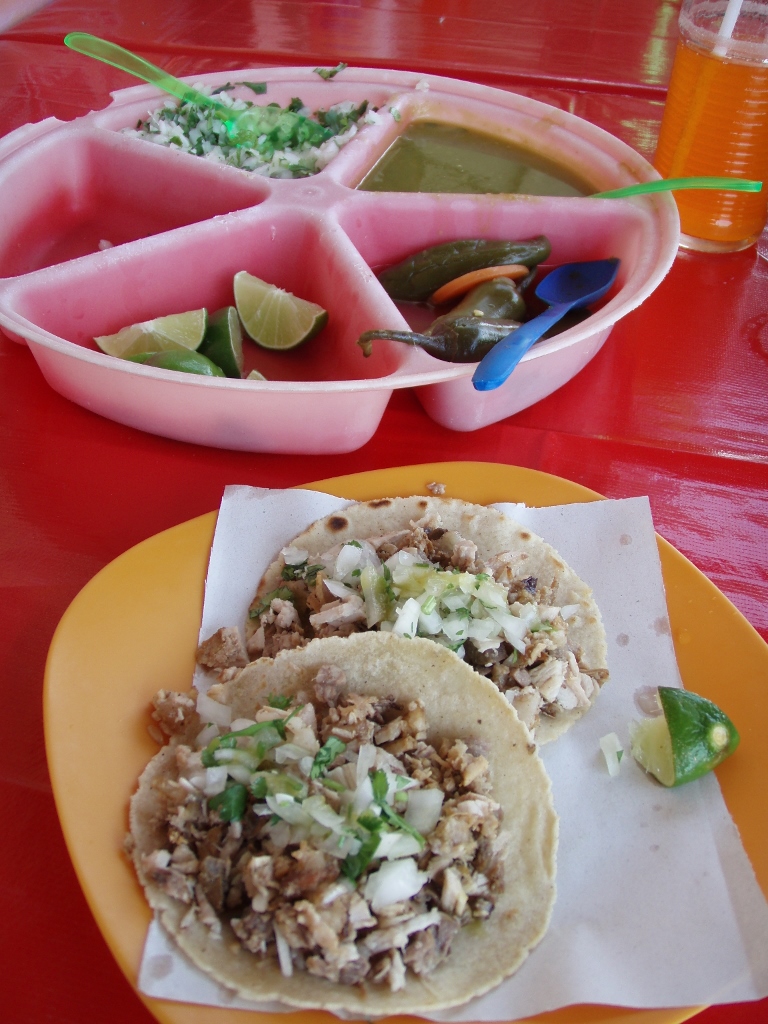 Chicken tacos
Chicken tacos
There were also a couple of fruit stands nearby, so I bought some for me.
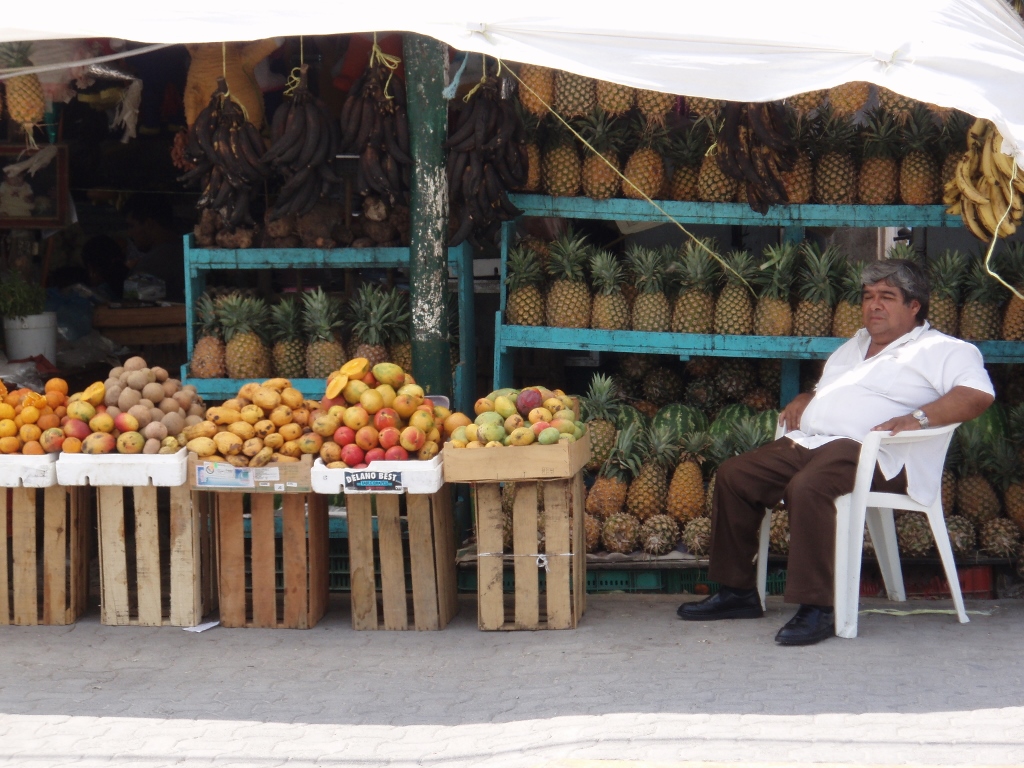 Fruit stand
Fruit stand
I also bought a magazine in Spanish and then I returned to the hotel where I left the surplus things in my room and then went to the part where the hotel’s beach beds were. As I’ve mentioned in the previous sequel of my travel stories, when I also showed a photo, these were double beds in the form of swings suspended from a wooden platform the upper part of which served as a sun deck, while the swinging beds were underneath and in deep shade.
I found one free beach bed and settled quite cosily, remaining there until the sunset.
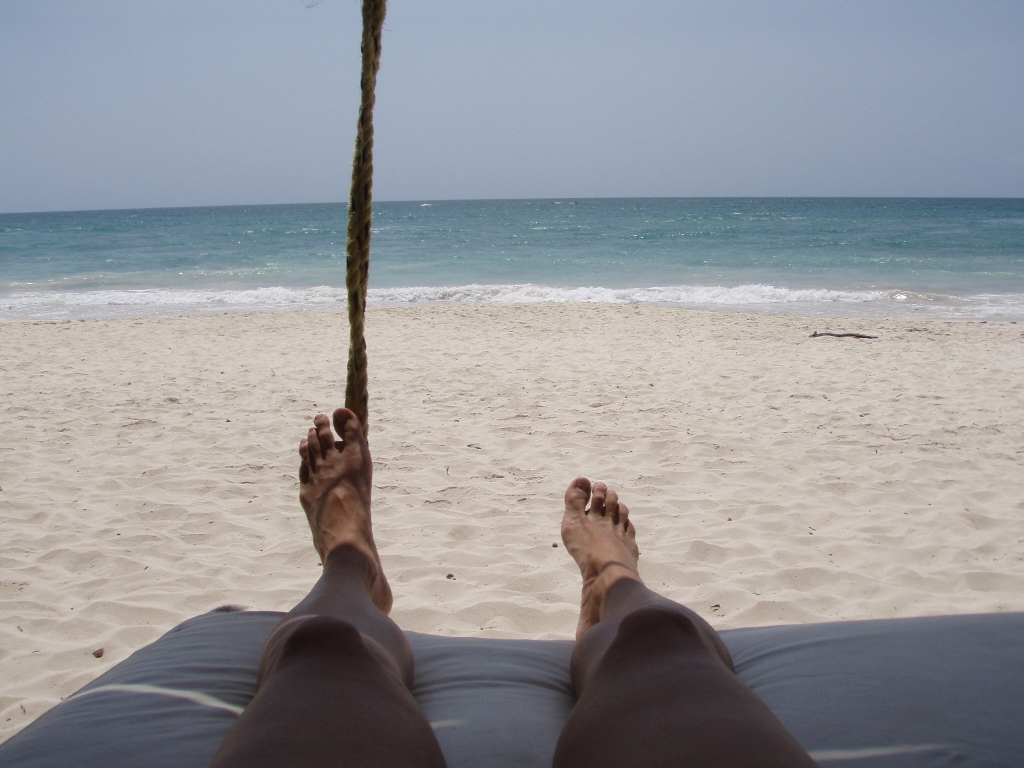 Beach bed with a view
Beach bed with a view
Although I went for a swim from time to time, I mostly spent my time idly, reading the magazine I had bought and only occasionally would I use my left foot to push the rope, thus swinging the entire bed. It felt wonderful to be that lazy.
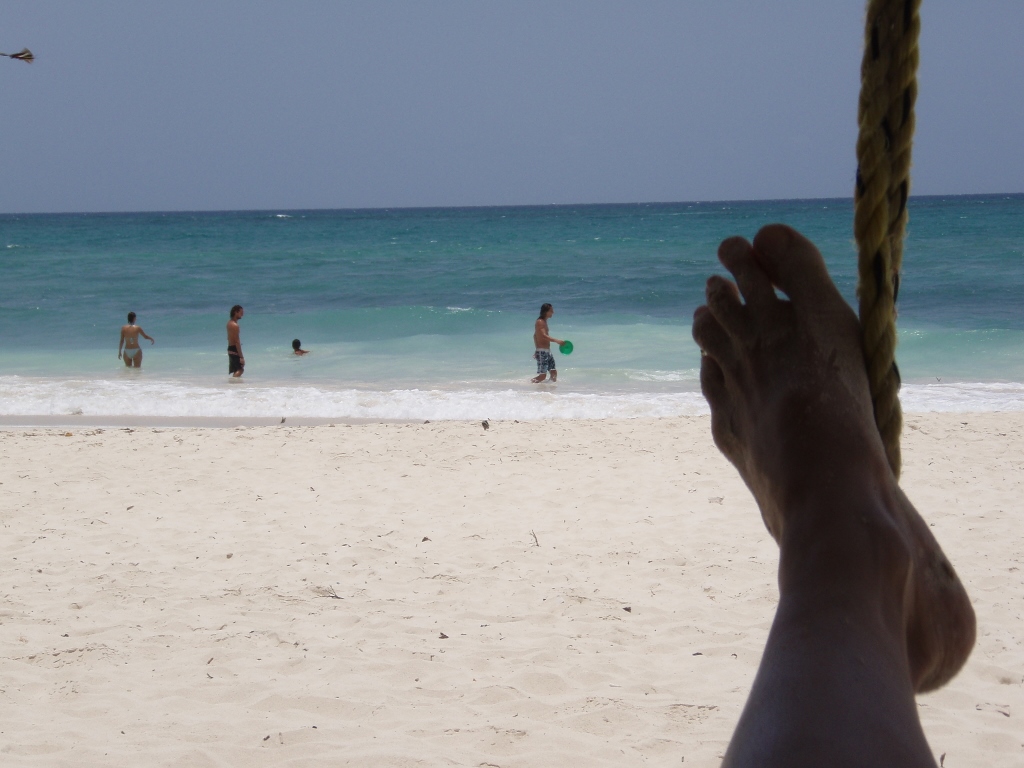 Beach bed with a view
Beach bed with a view
While lying there I also watched from time to time what was happening on the beach. Thus I saw a girl who very “bravely” sunbathed in very strong sunlight, although it could be seen that her shoulders were completely red. It seemed this was not enough for her.
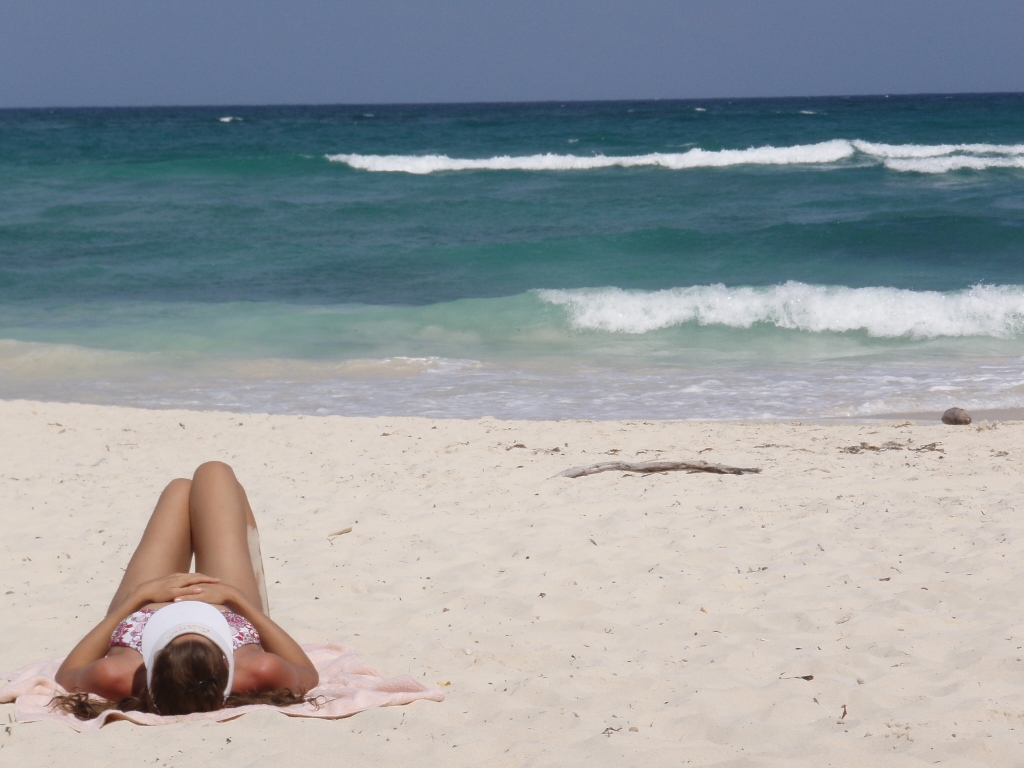 Shoulders are already sunburned, why not the entire body
Shoulders are already sunburned, why not the entire body
It was precisely this afternoon that I had an interesting, albeit slightly unpleasant experience. Since I was lying in the deep shade and already had a very good base from Belize, I thought there was no need to put any suntan lotion on. Wrong! The reflection of the sunrays against the white sand was obviously so strong that I even managed to sunburn a little over the already existing darker tan. I don’t even want to think how the girl from the photo above lying out in the open fared.
Still, I did not spend the entire afternoon lying down, but in addition to the occasional swimming, I also took photos of the beach when the colours were still quite bright.
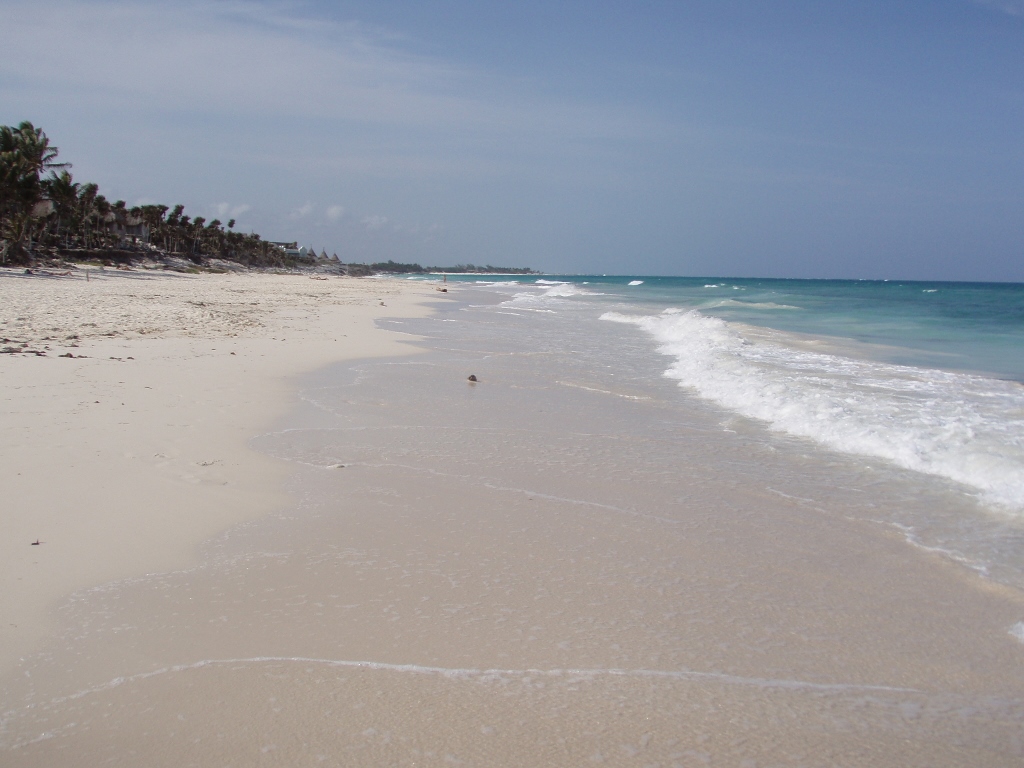 Beach in Tulum by the hotel at which I stayed
Beach in Tulum by the hotel at which I stayed
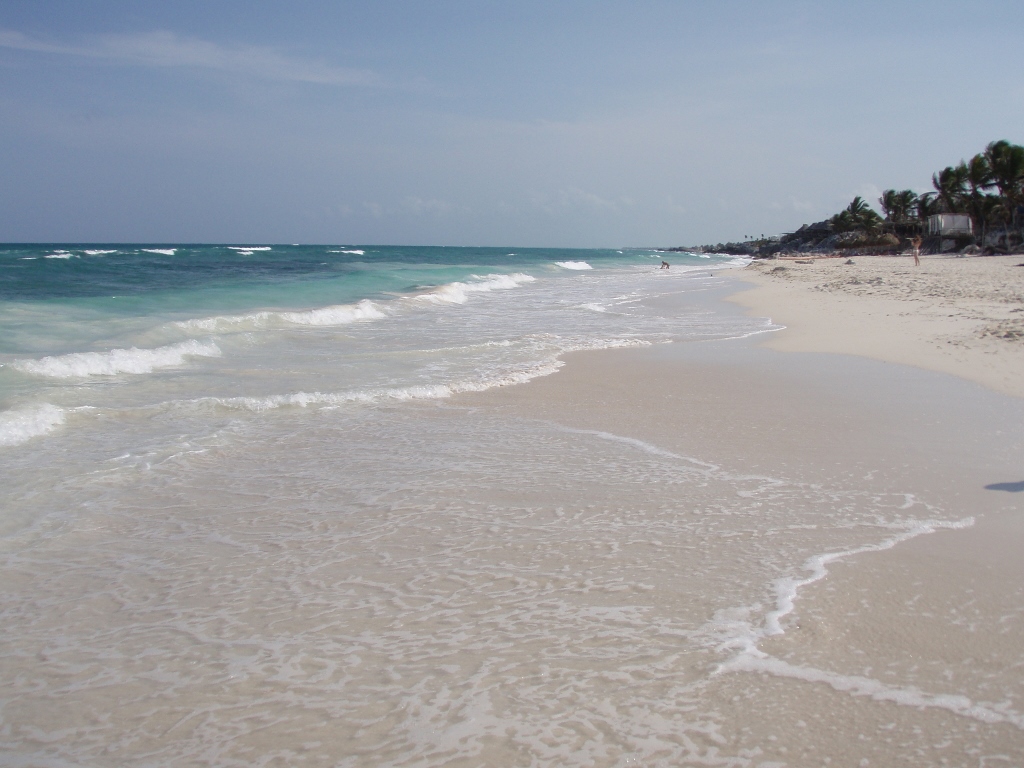 Beach in Tulum by the hotel at which I stayed
Beach in Tulum by the hotel at which I stayed
When the dusk came, I went for a walk on the beach enjoying the warm wind that was blowing. In addition, the waxing Moon was already out and on the east side of the sky I could see some light effect in which I recognised letter V that is the initial of my name. I decided to interpret this as an open invitation, as well as a confirmation that I would come back here. And that was ideal for my last evening in Mexico and Central America in 2008.
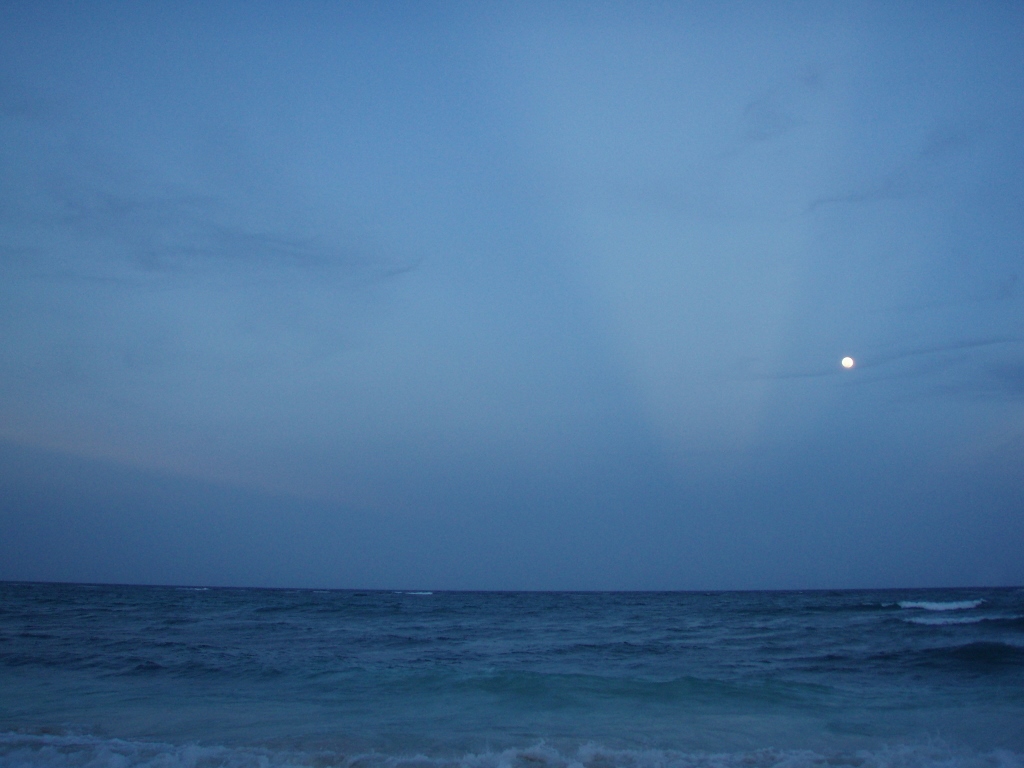 Open invitation to come back here again
Open invitation to come back here again
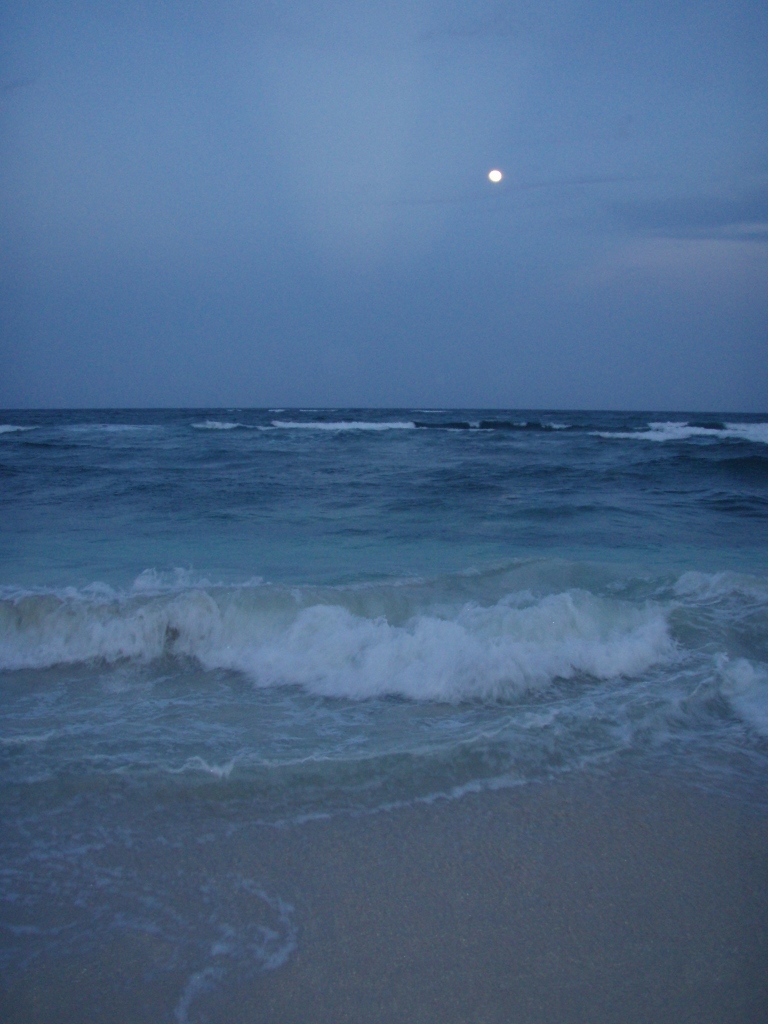 Open invitation to come back here again
Open invitation to come back here again
In the evening I had enchiladas for dinner and drank beer, after which I returned to my room and went to bed earlier, although before that I did walk some more along the beach that was lit by the moonlight.
The next morning I got up again, already at 6 am, and again I went for a walk along the beach. Later I took a shower, washed my hair, ate the fruit I had bought the day before and then I went to the hotel’s restaurant to have coffee. I was very relaxed and it felt good.
A little later I went back to my room, finished with the packing and then I was ready to go.
When I got to the coach terminal in Tulum, I was told again that I could not buy the ticket in advance, since the coach was coming from elsewhere and was just passing through, and that I should wait. Silently I told them in no uncertain terms what they should do.
At some point I got into one of the collective (line) passenger vans and thus I transferred to the town of Playa del Carmen where I could finally buy a ticket for a coach that drove from there directly to the airport in Cancun.
Here is the map that shows the roads I travelled during this magnificent journey around Mexico and Central America in 2008.
I got to the airport very early, but I never really mind this, spending my time nicely and finding the ways how to “entertain” myself. Later, while I was waiting to board the plane, I sat beside a young woman from Mexico and her son, and we started chatting. When her boy heard I was from Serbia he was completely delighted, for he knew of some Serbian footballers (Kežman, Mijatović and Mihajlović). This meant so much to him that he even asked to have a photo with me. Still, no matter how cordial and intensive the chatting with Guadalupe (the mother) was, at some point the two of them had to leave, for their plane was departing before mine.
I waited some more and then I also boarded the plane that left on time. I was going back home.
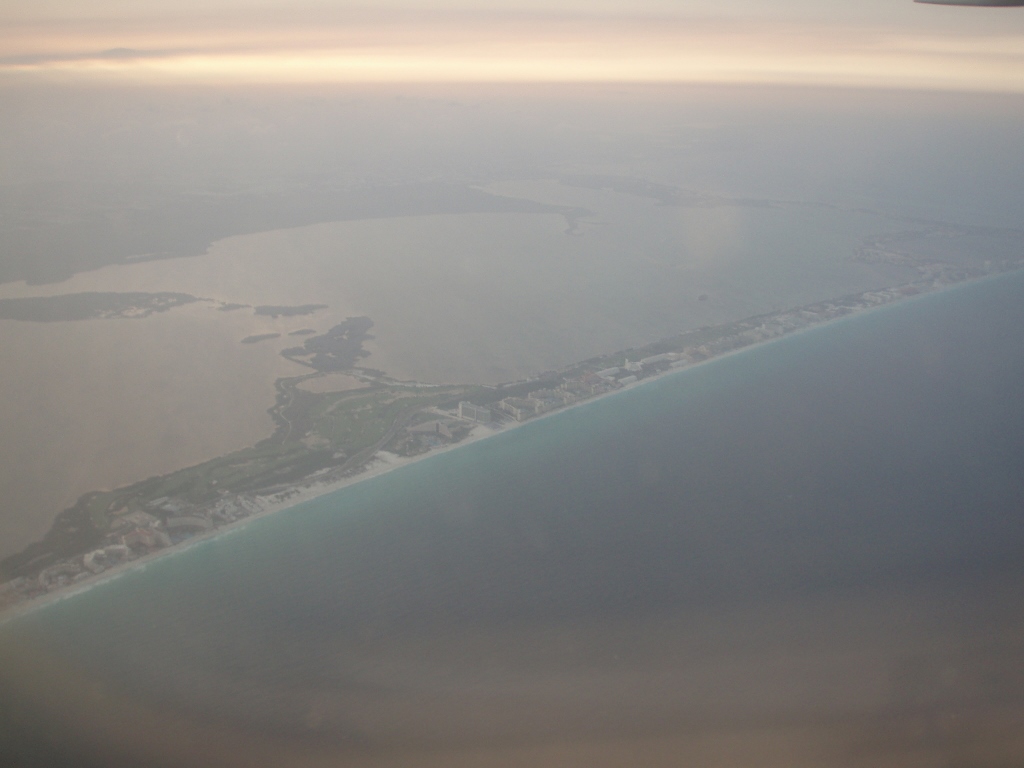 Aerial view at Cancun
Aerial view at Cancun